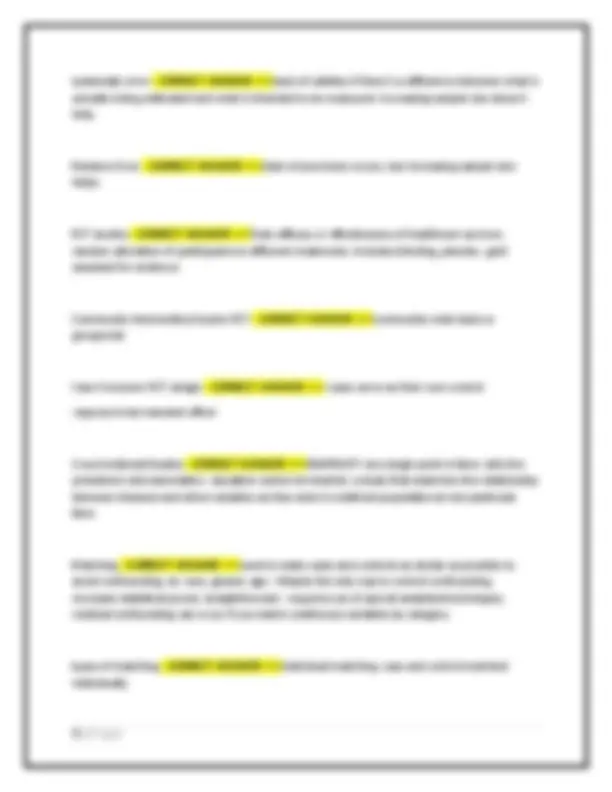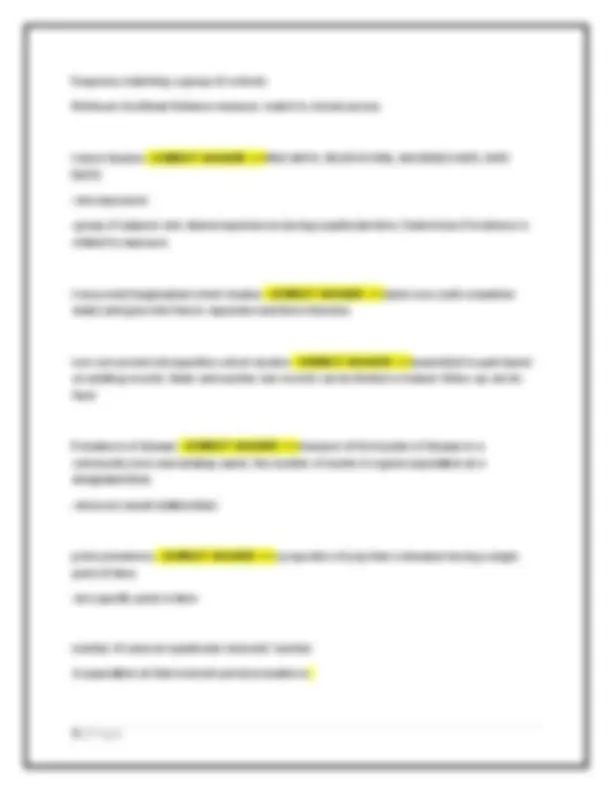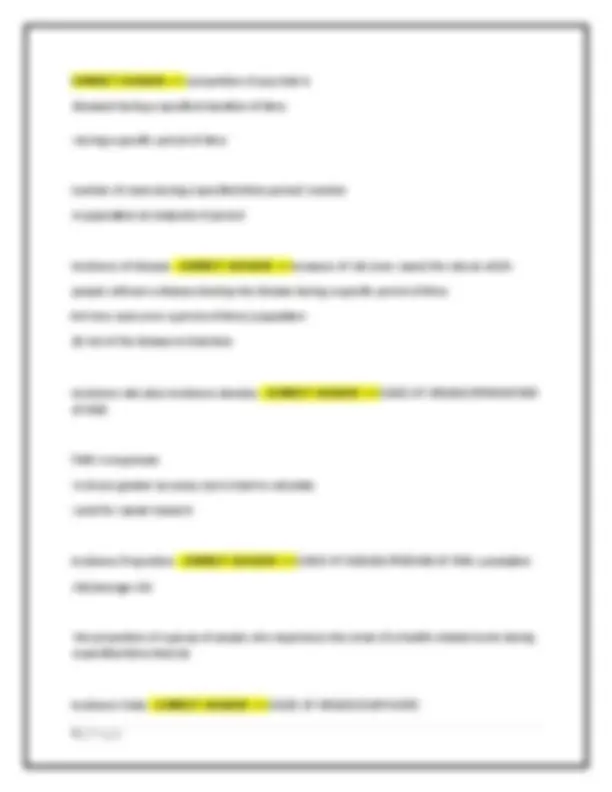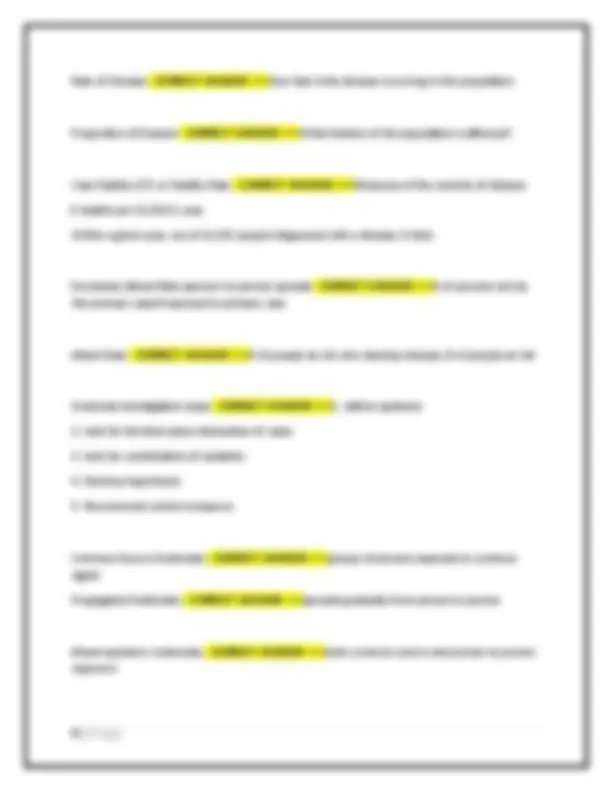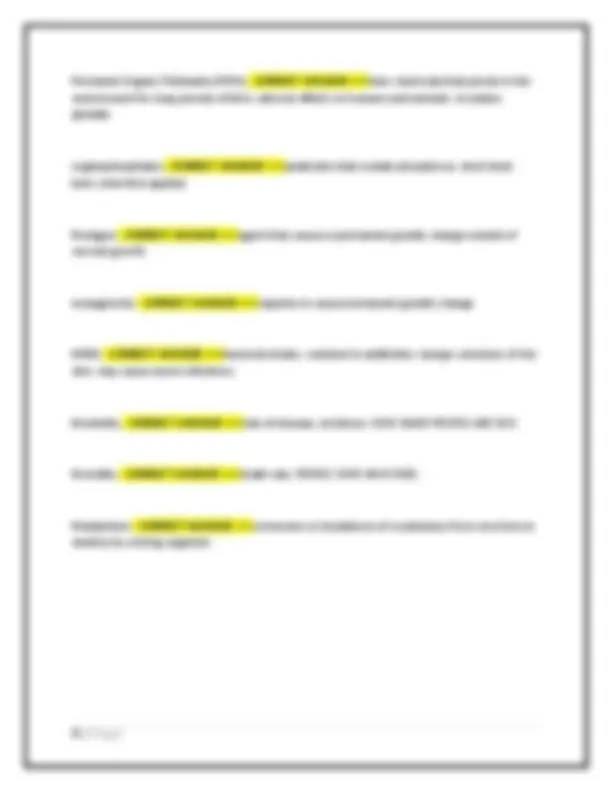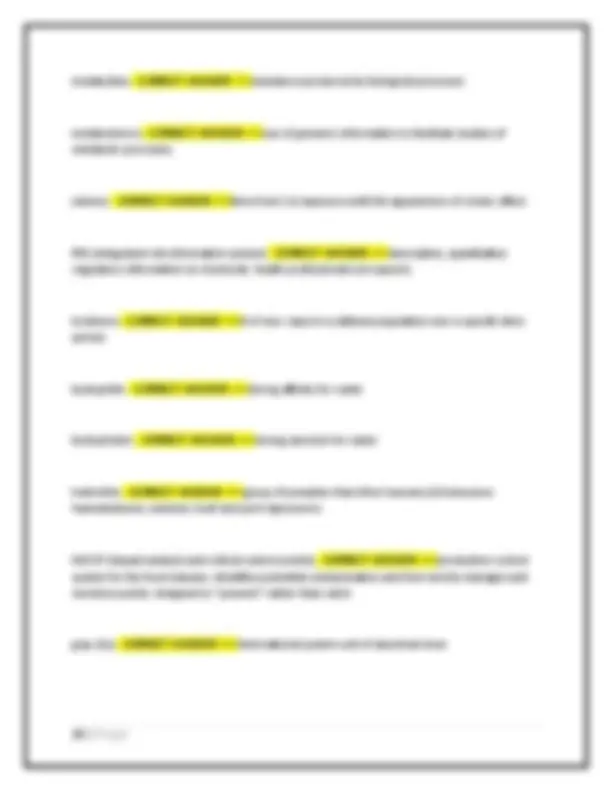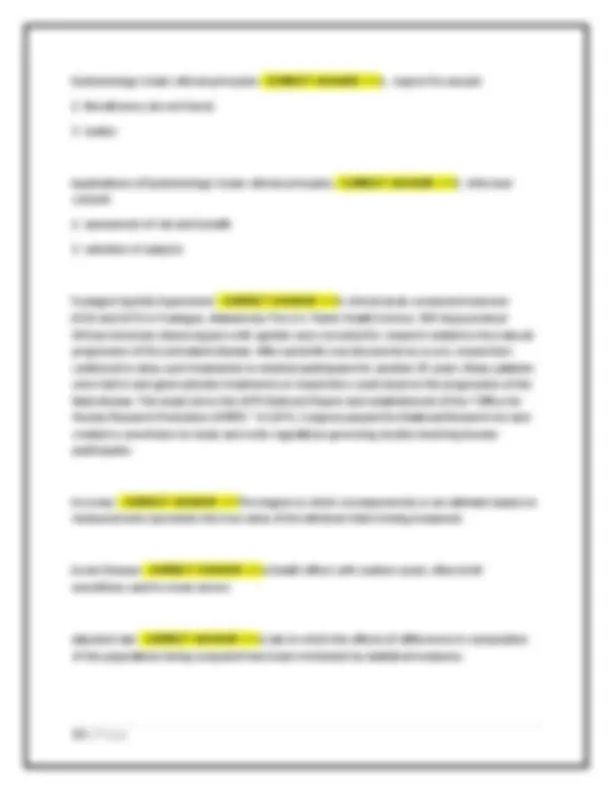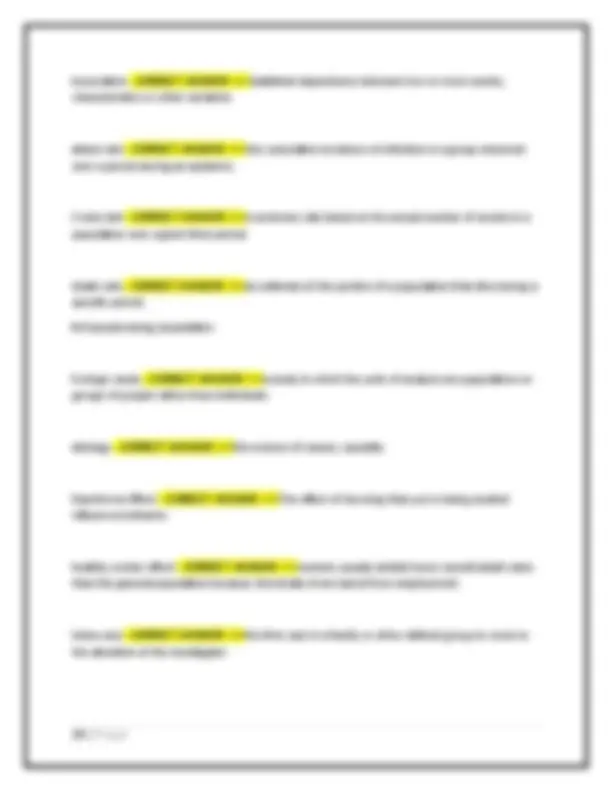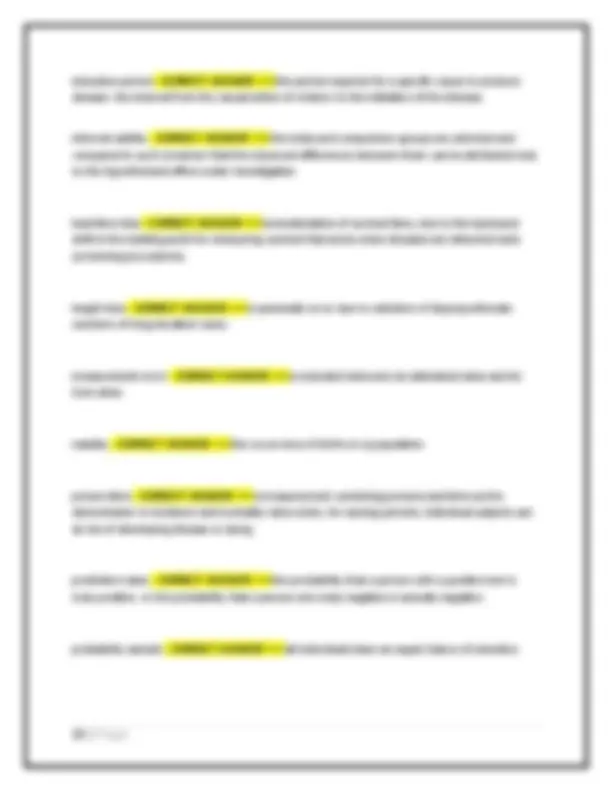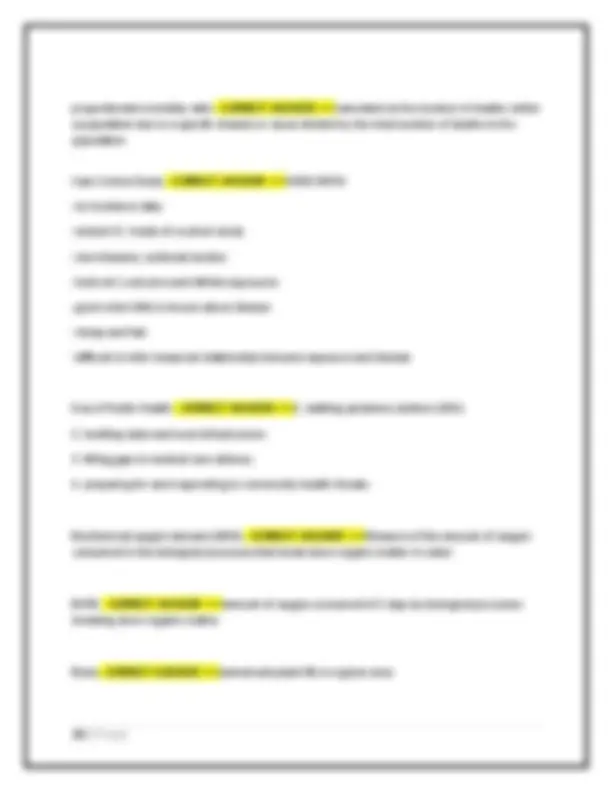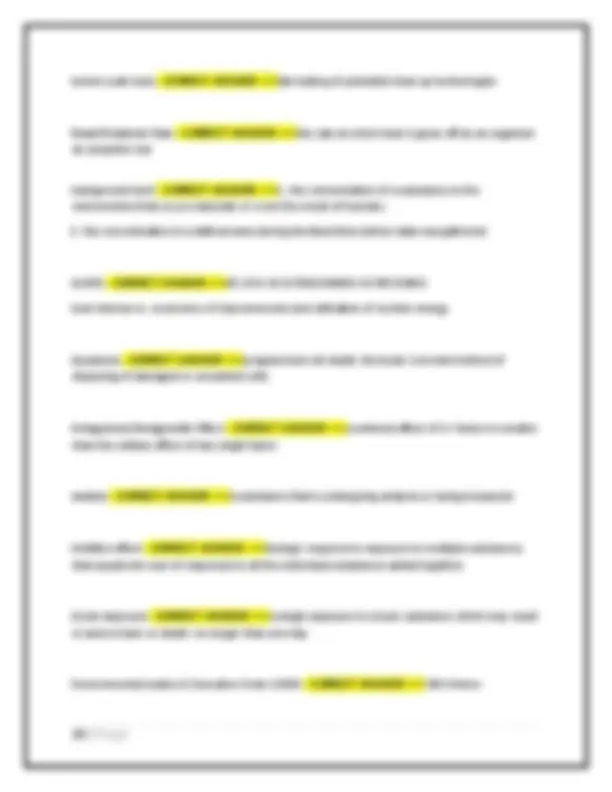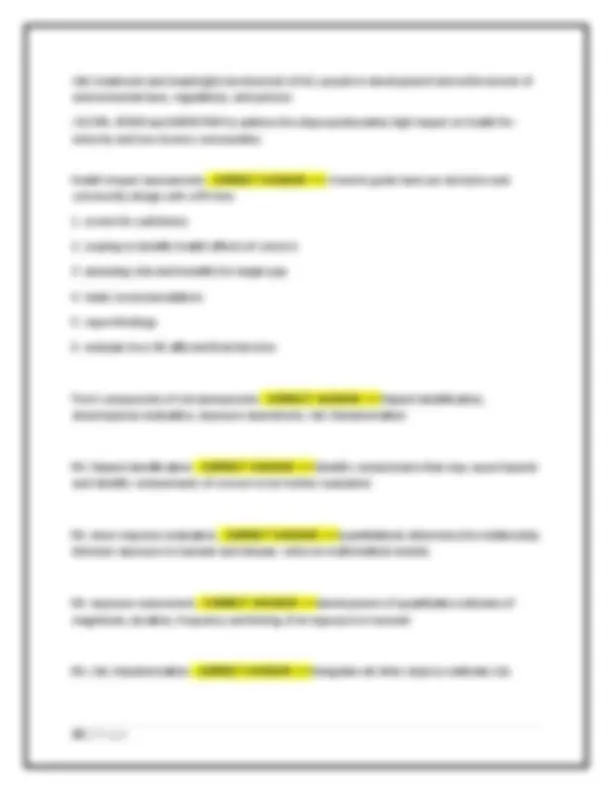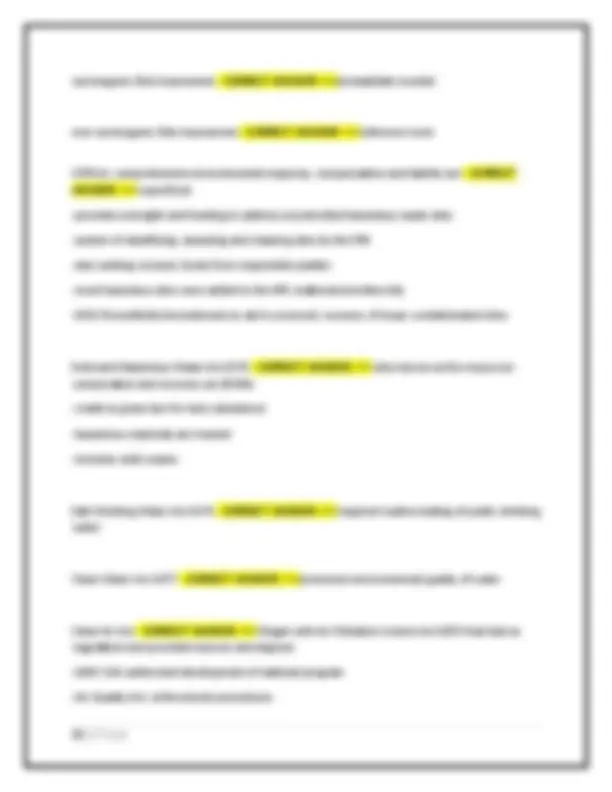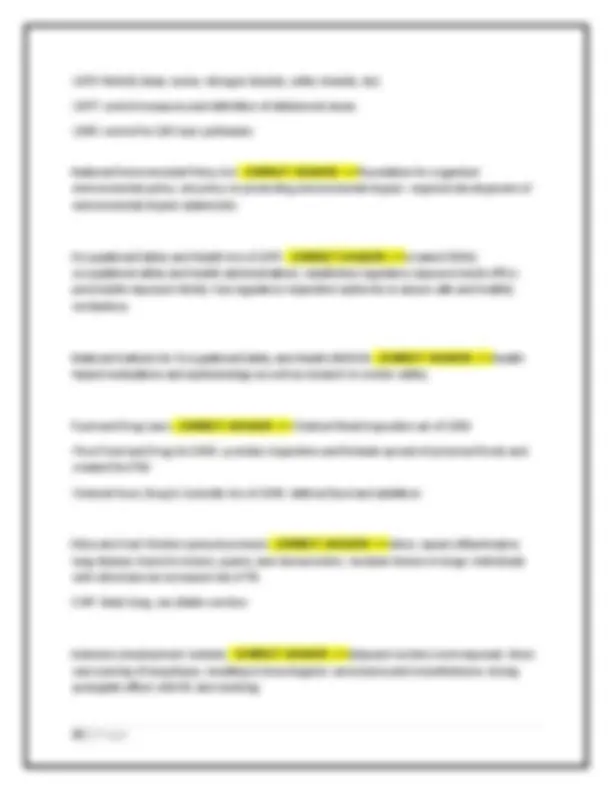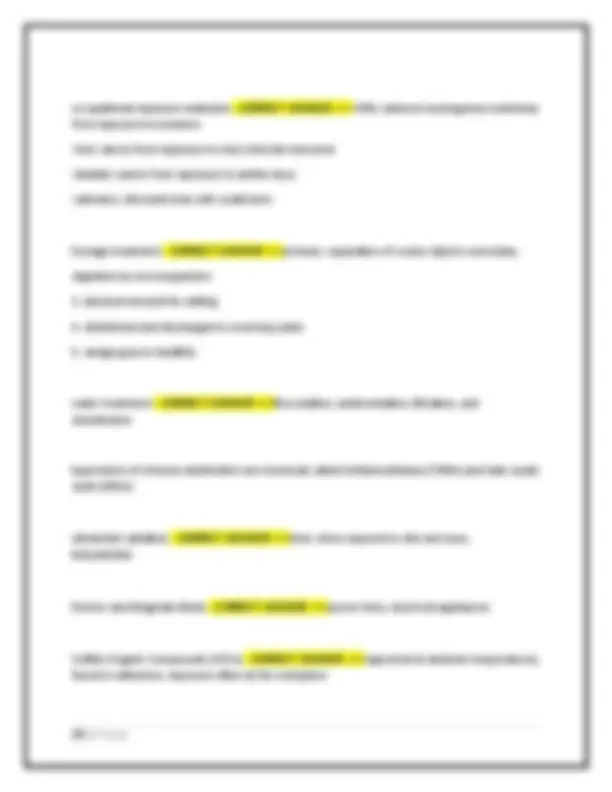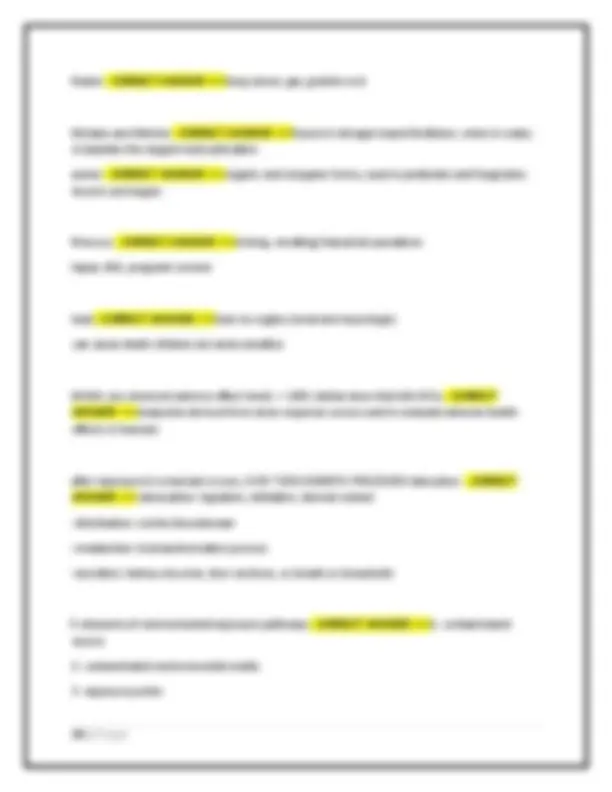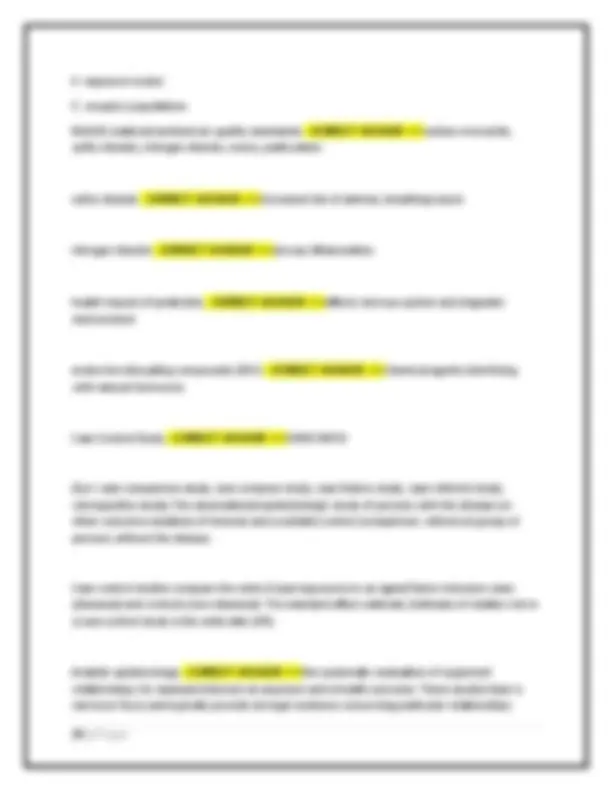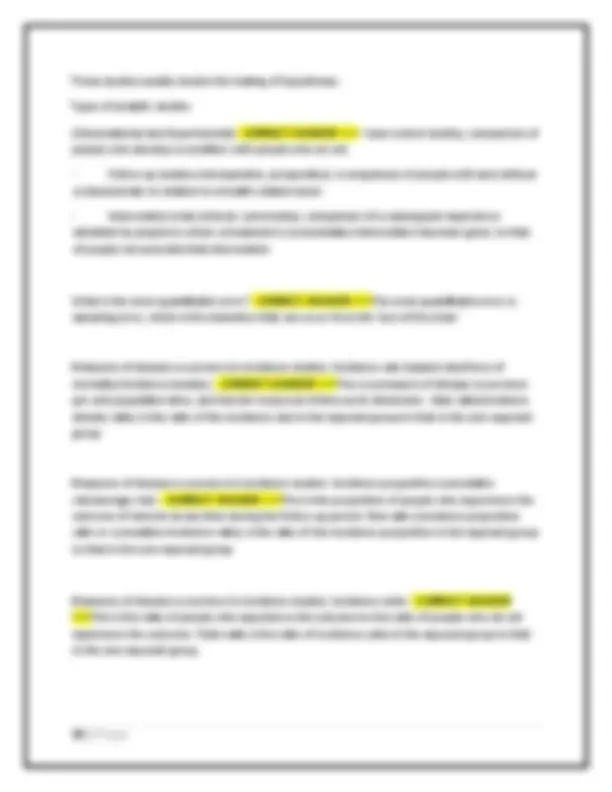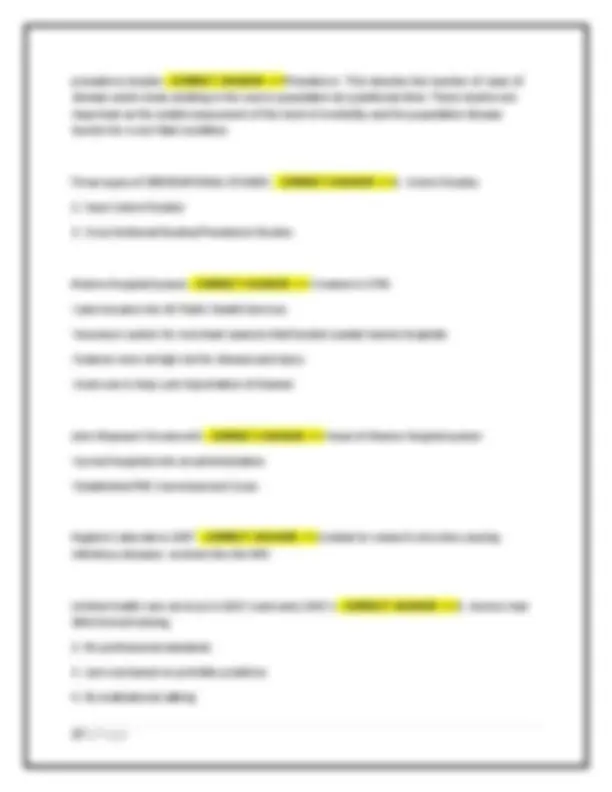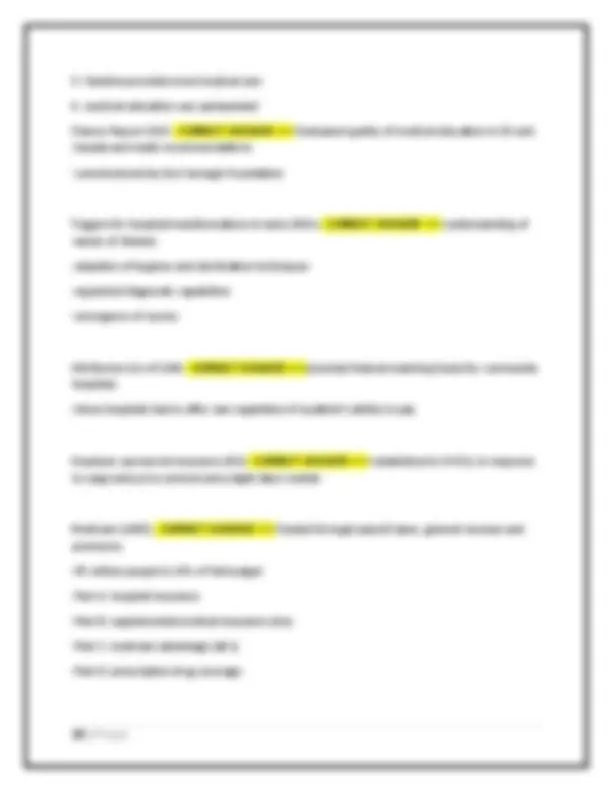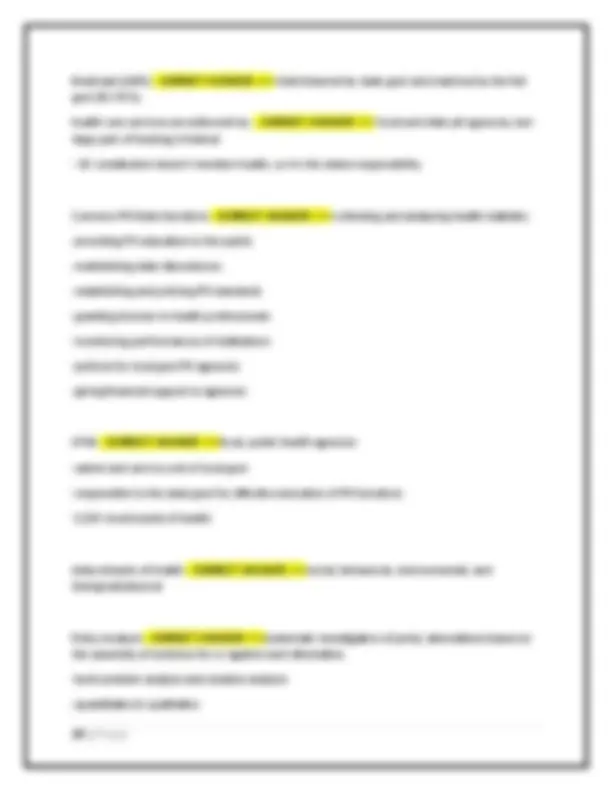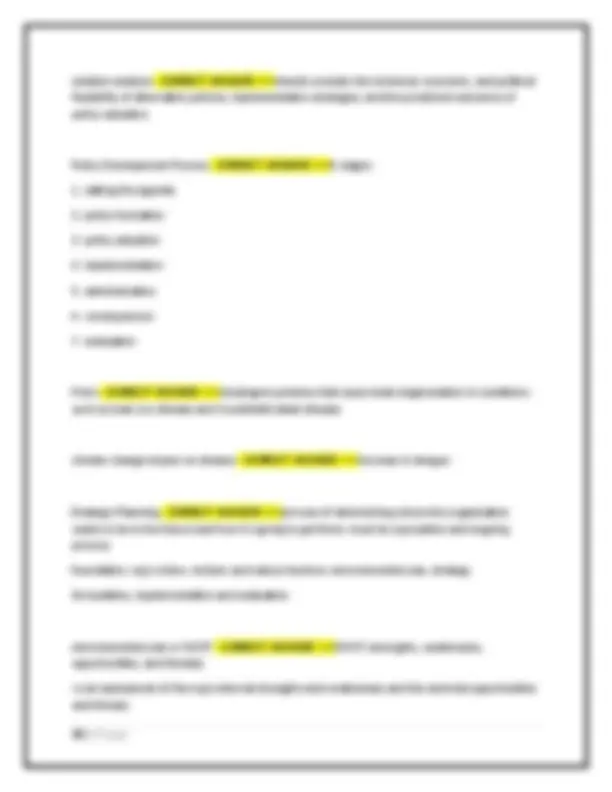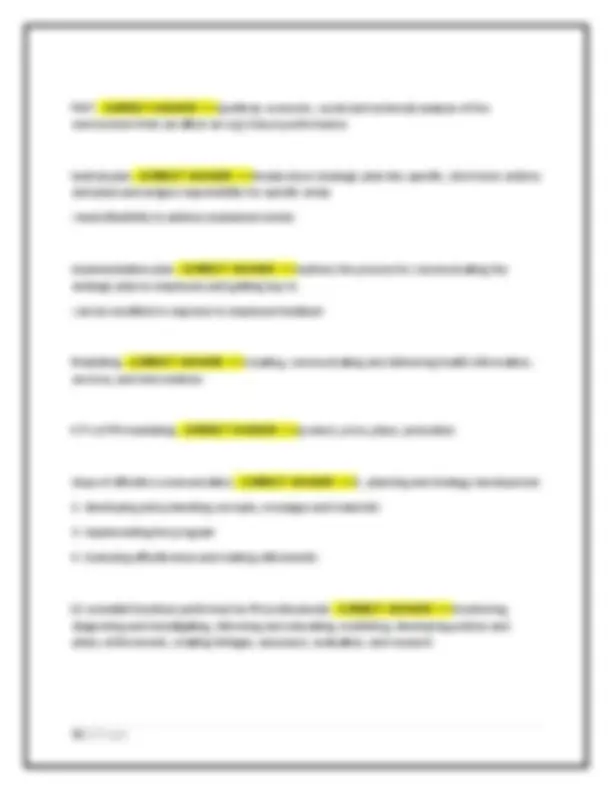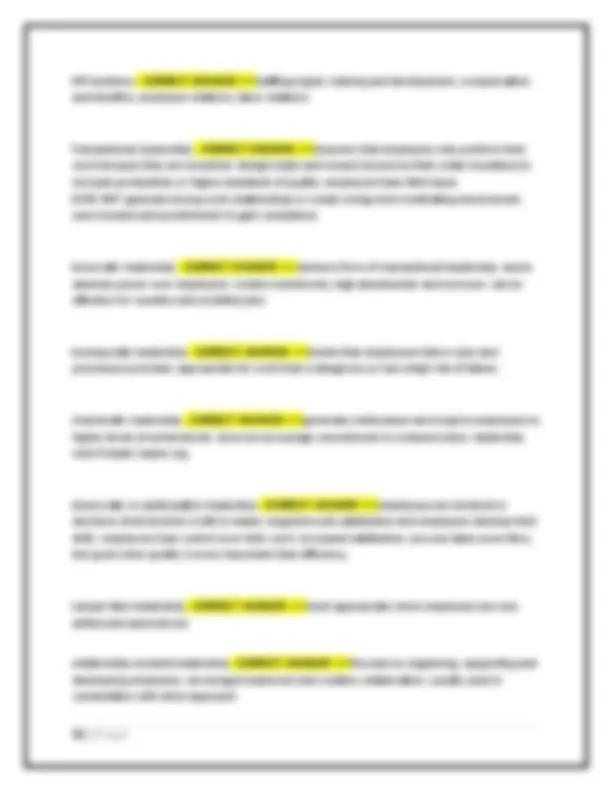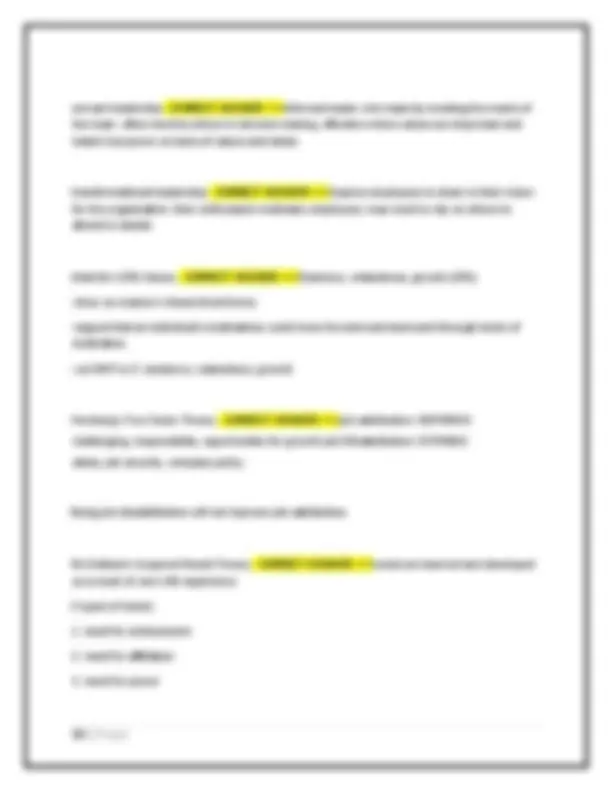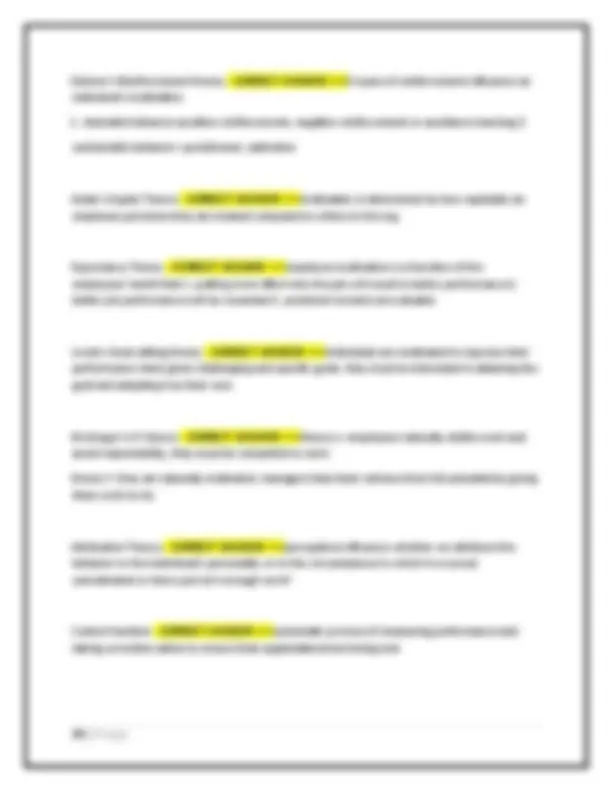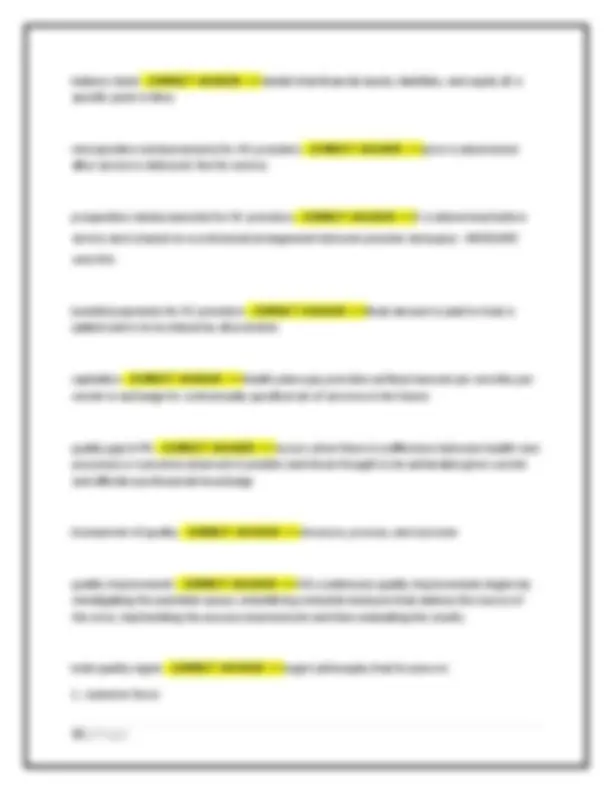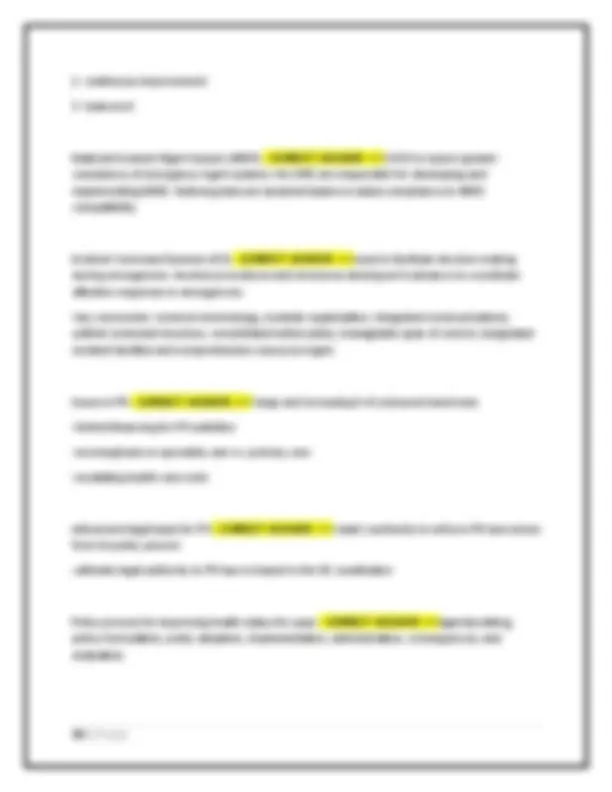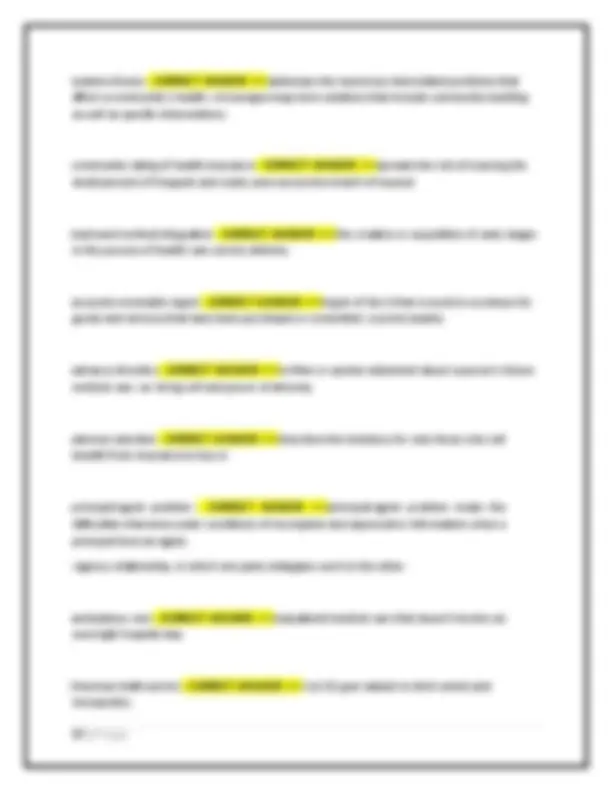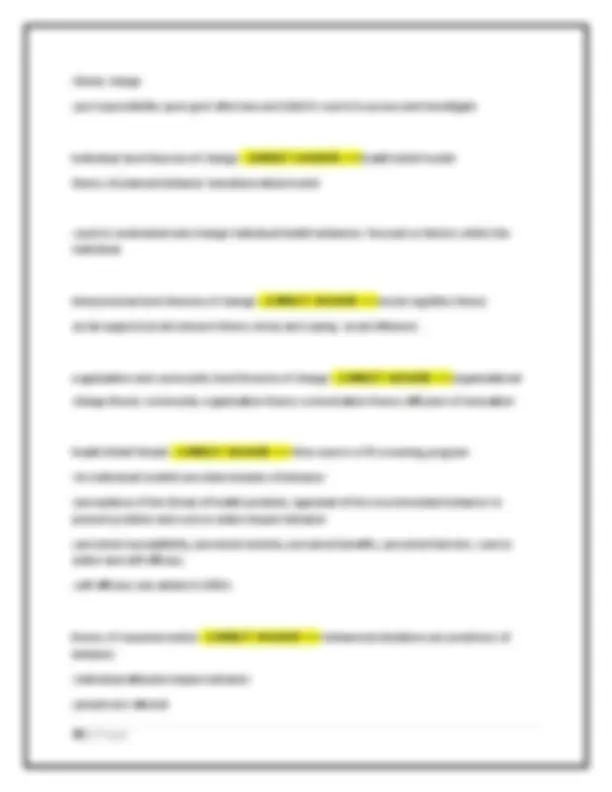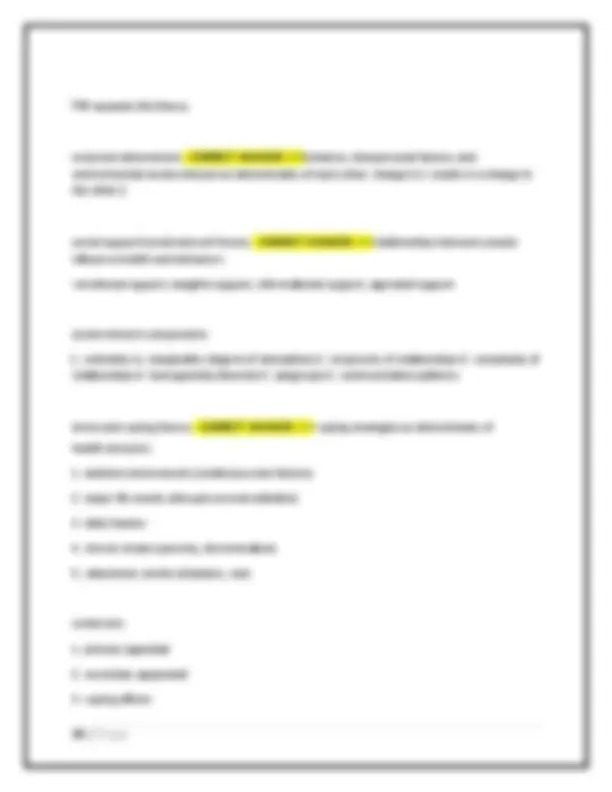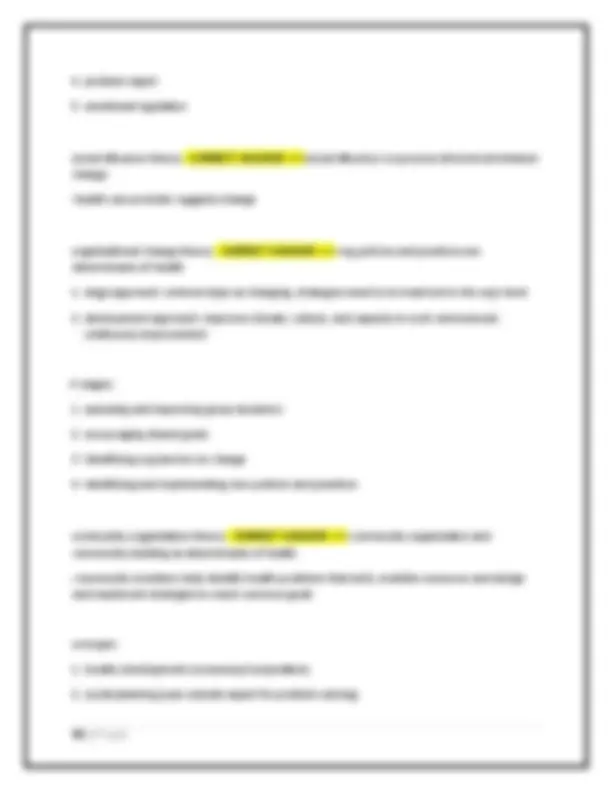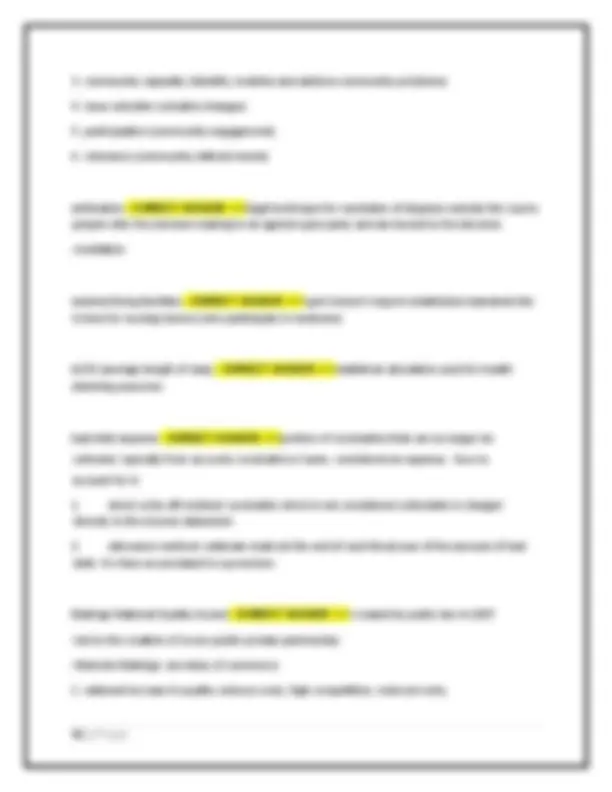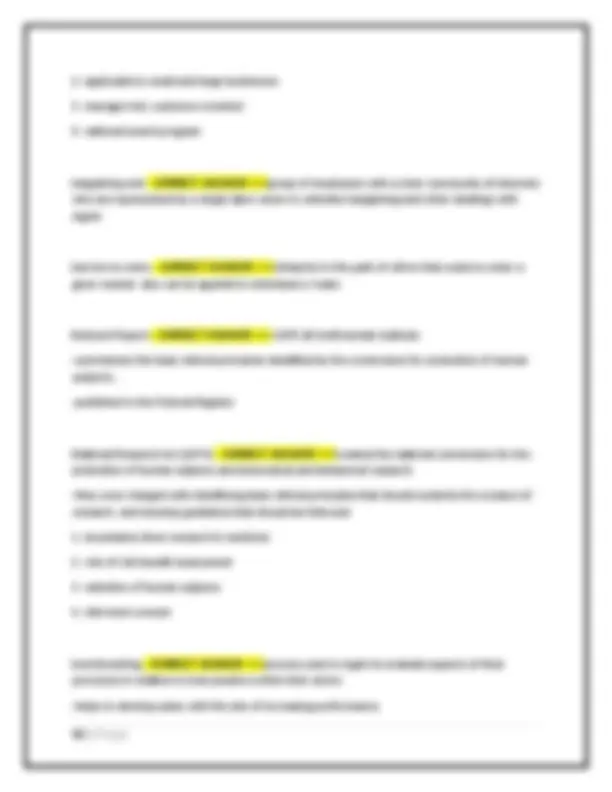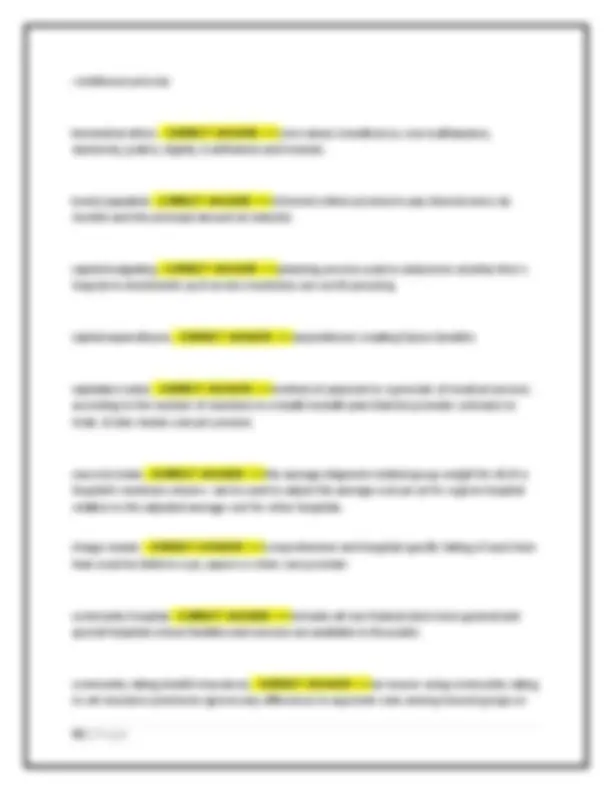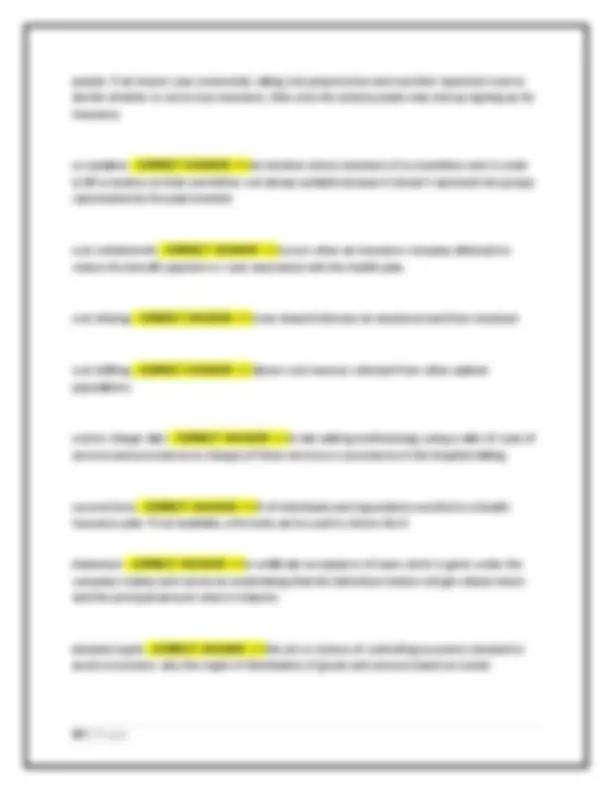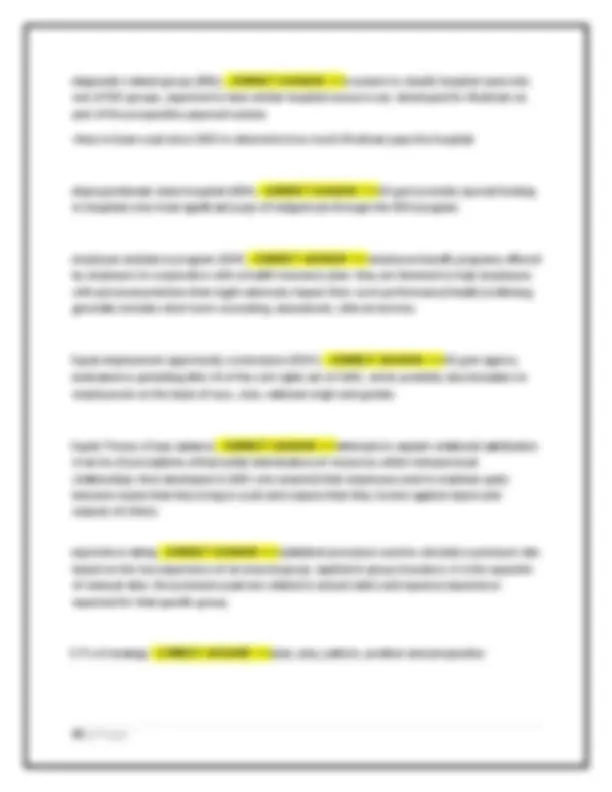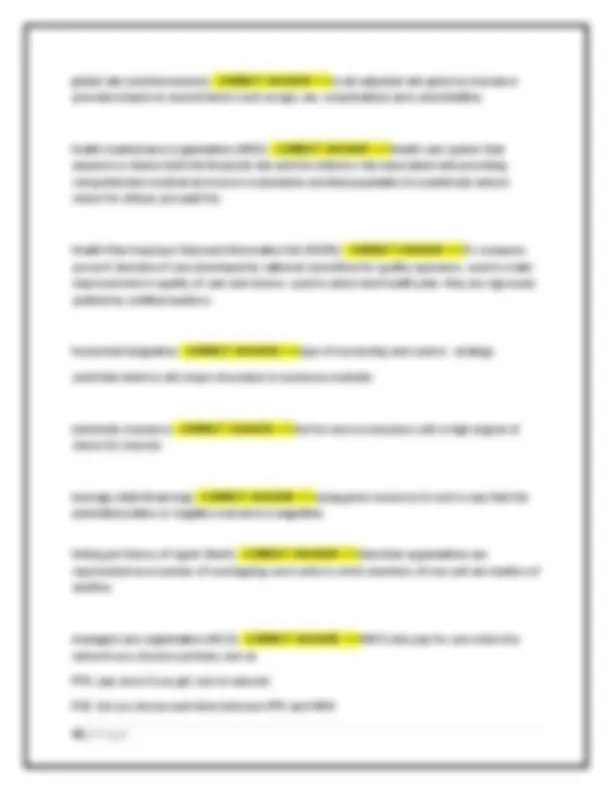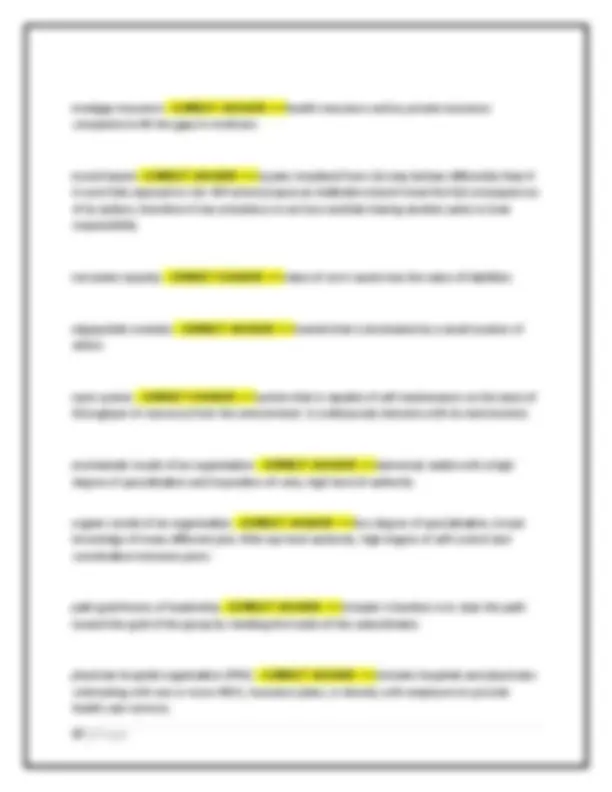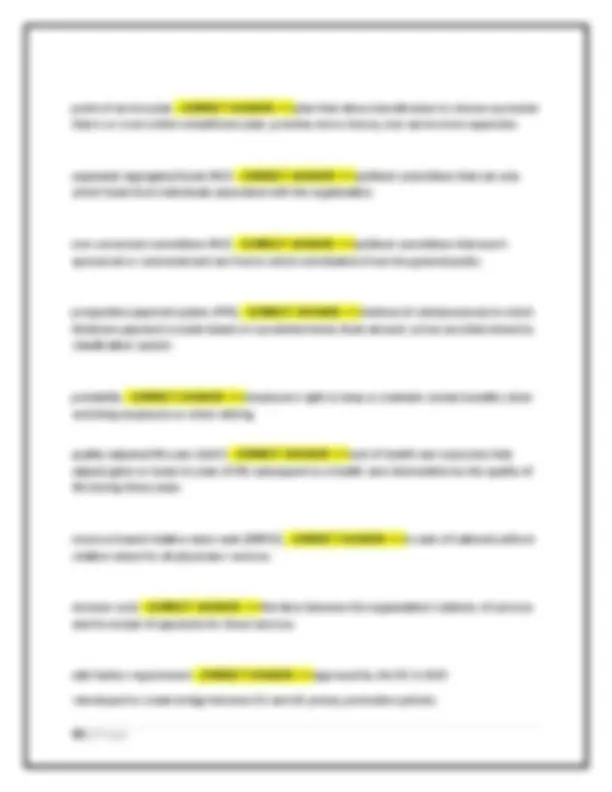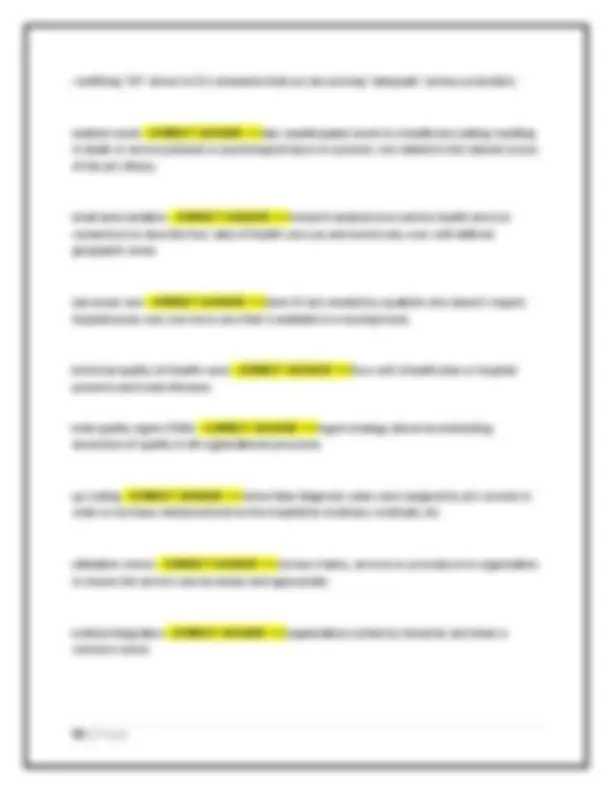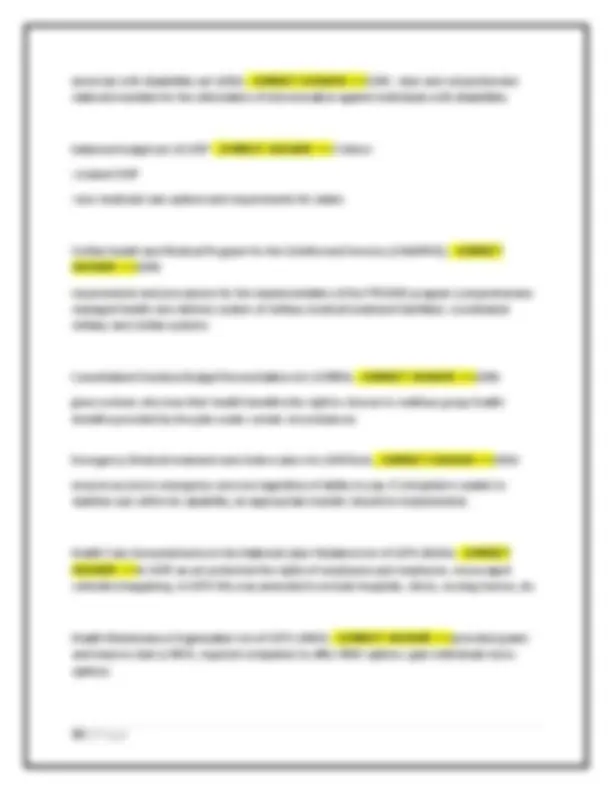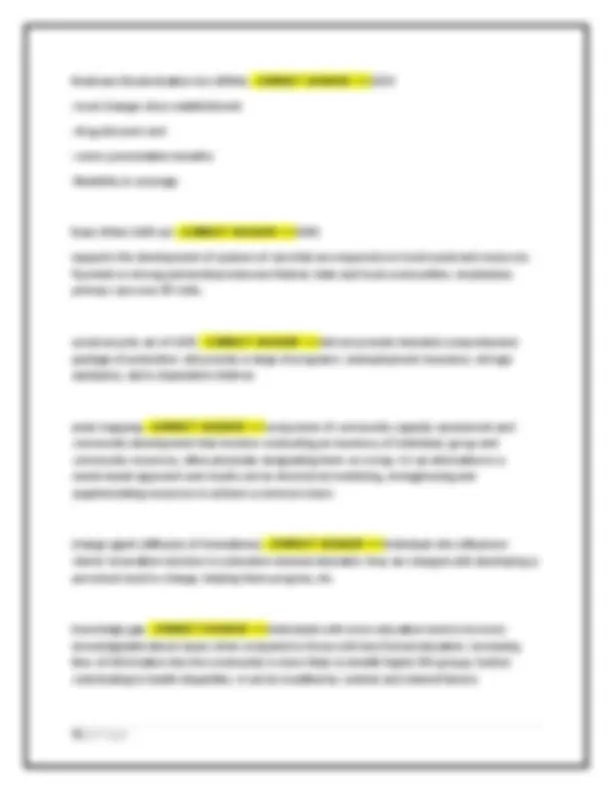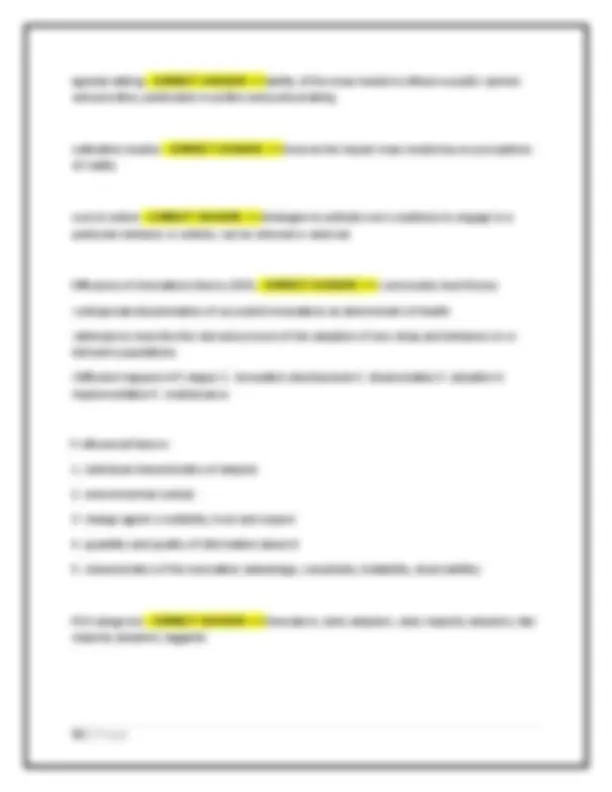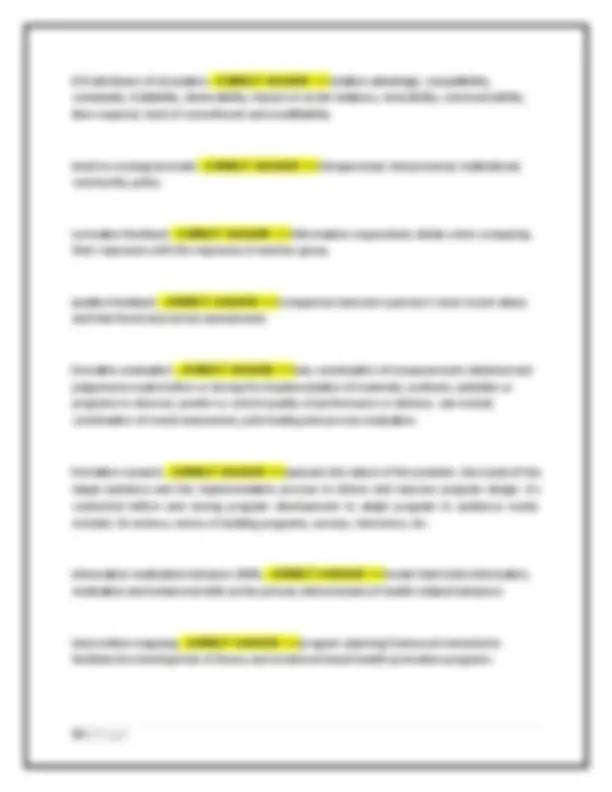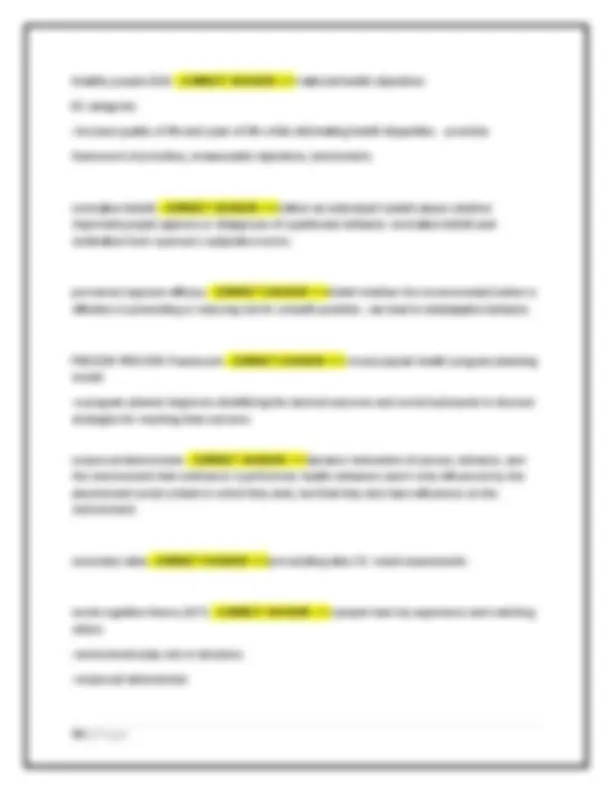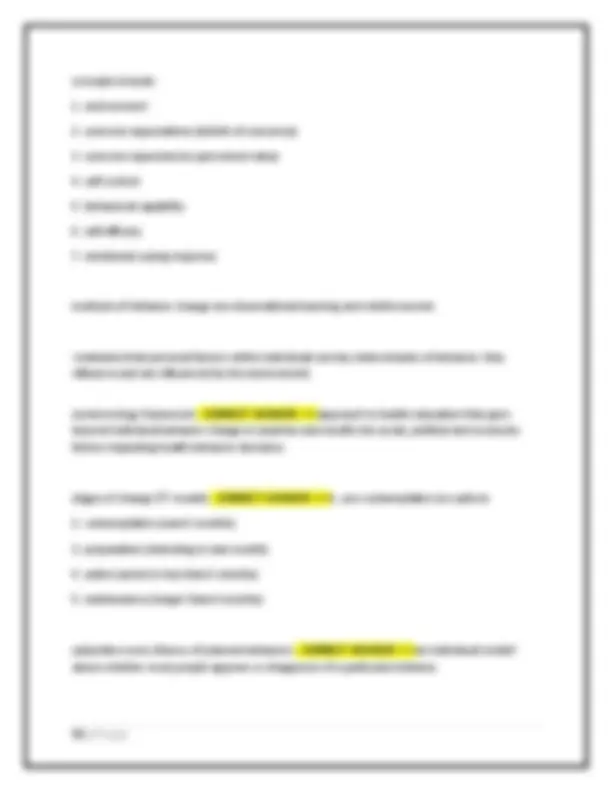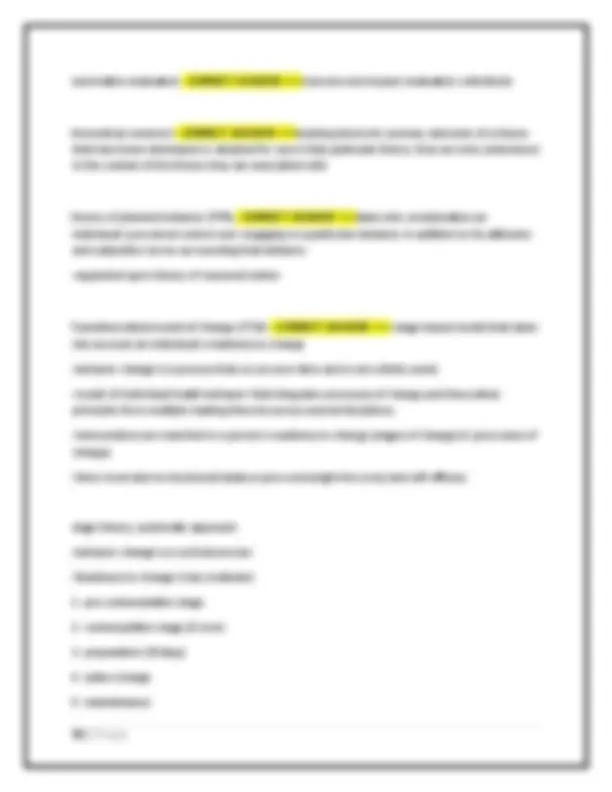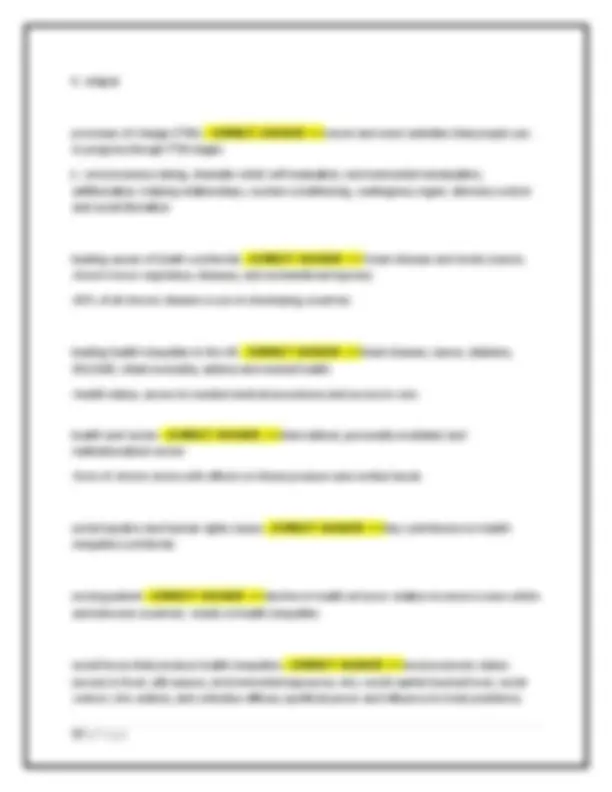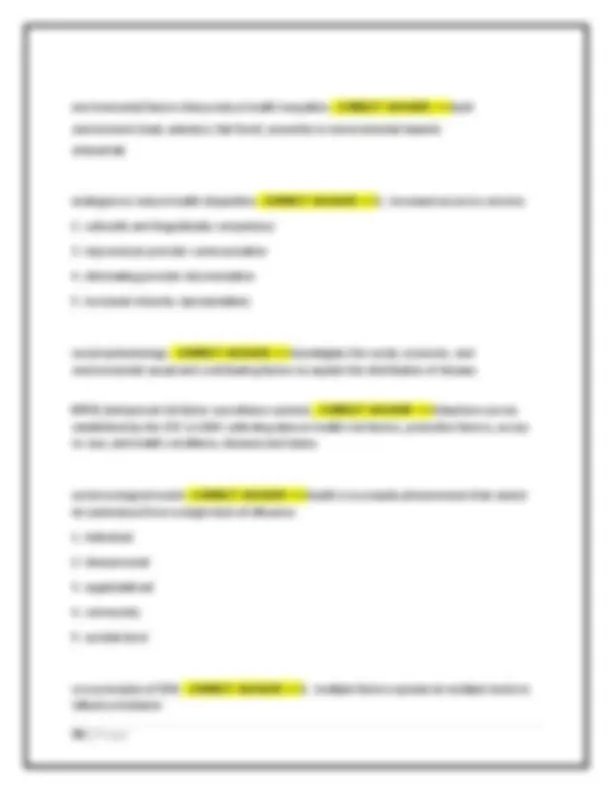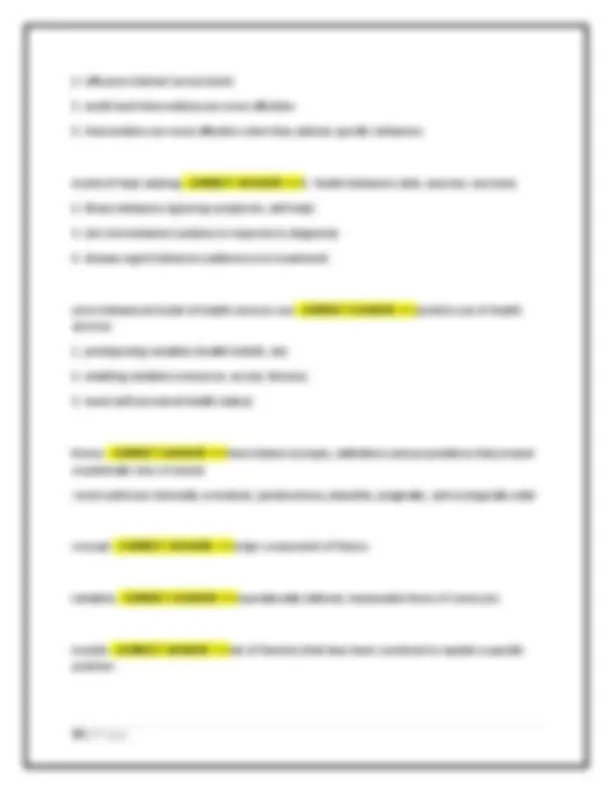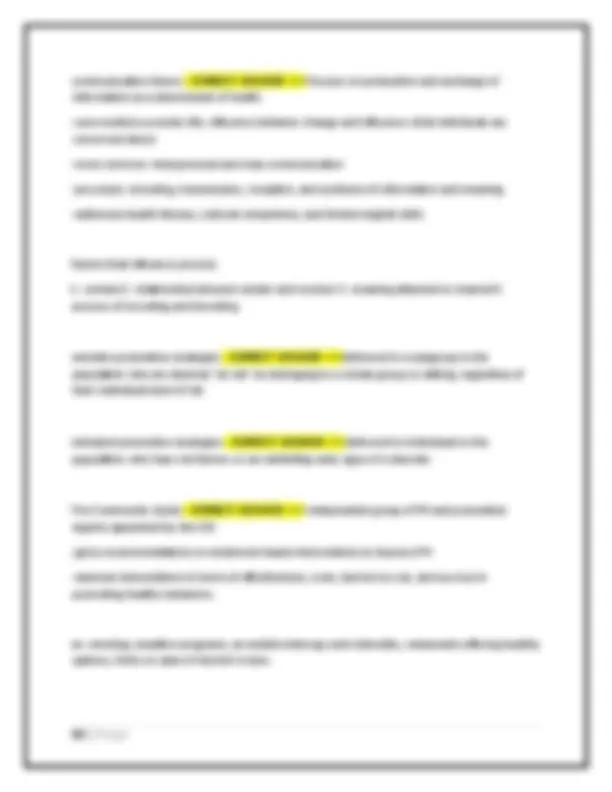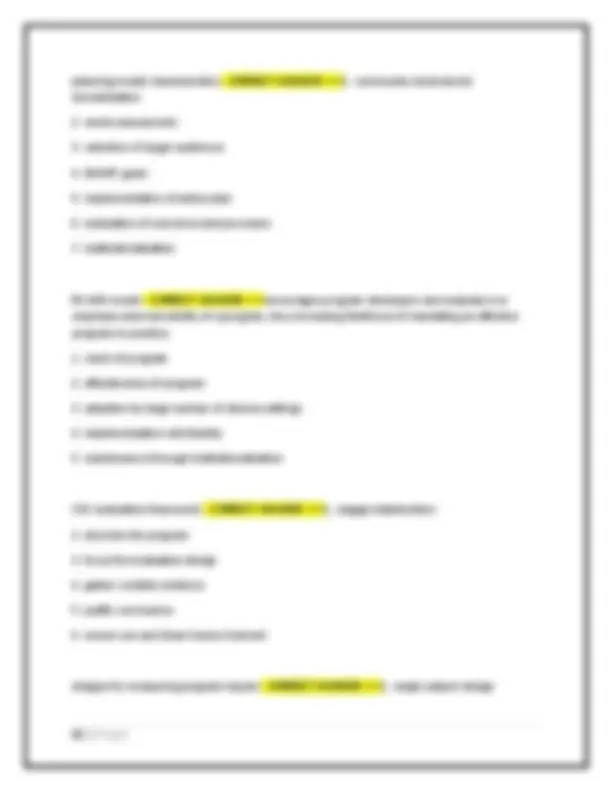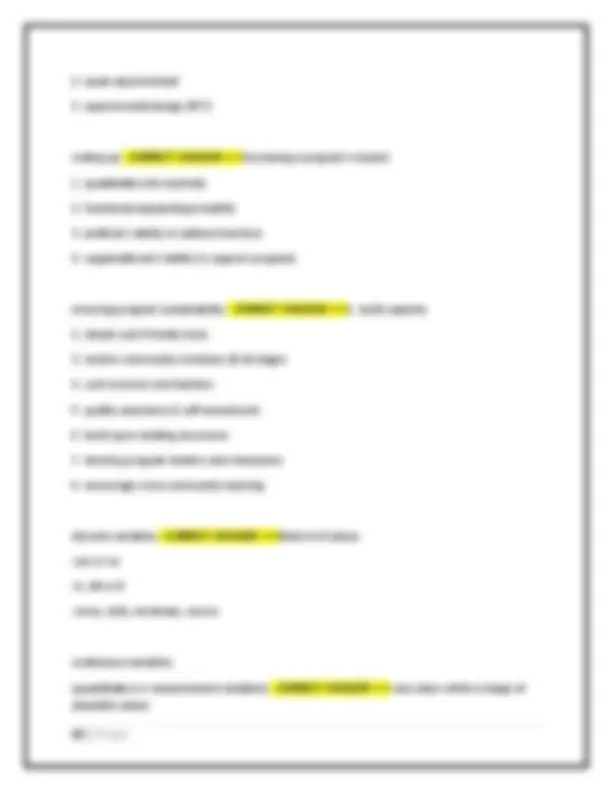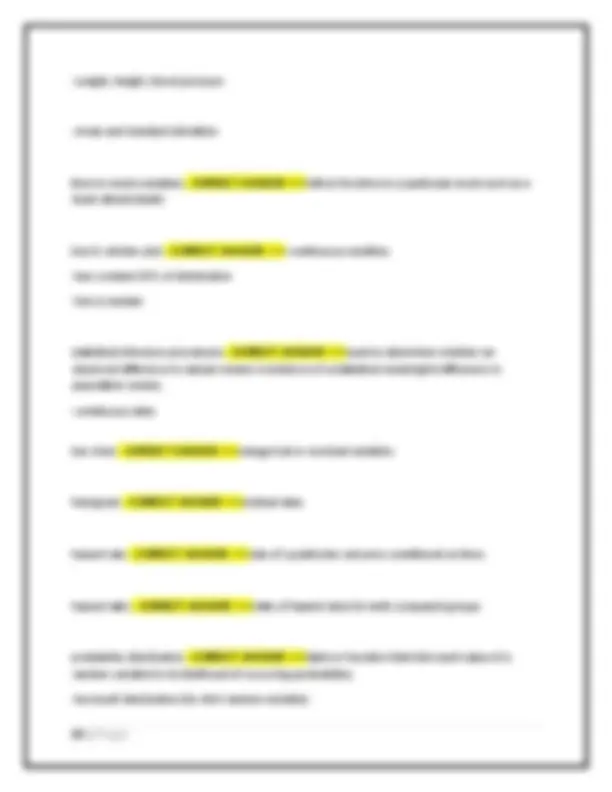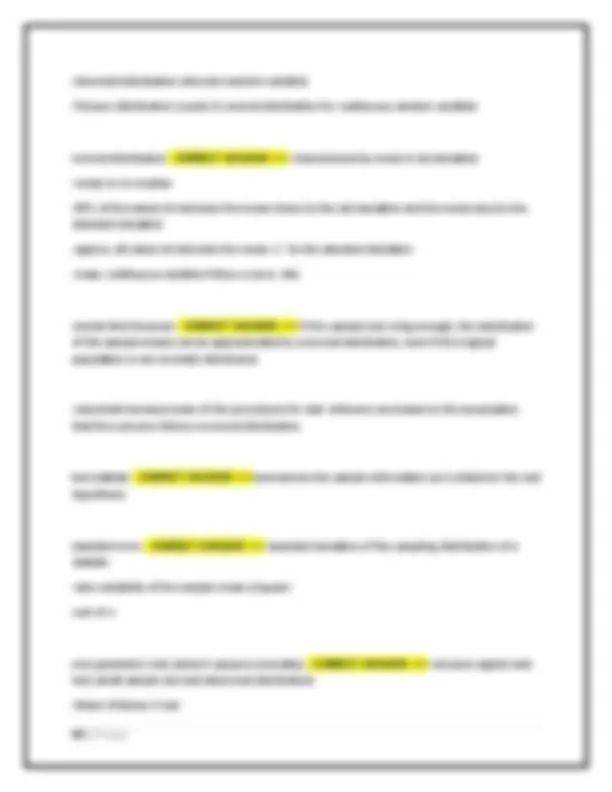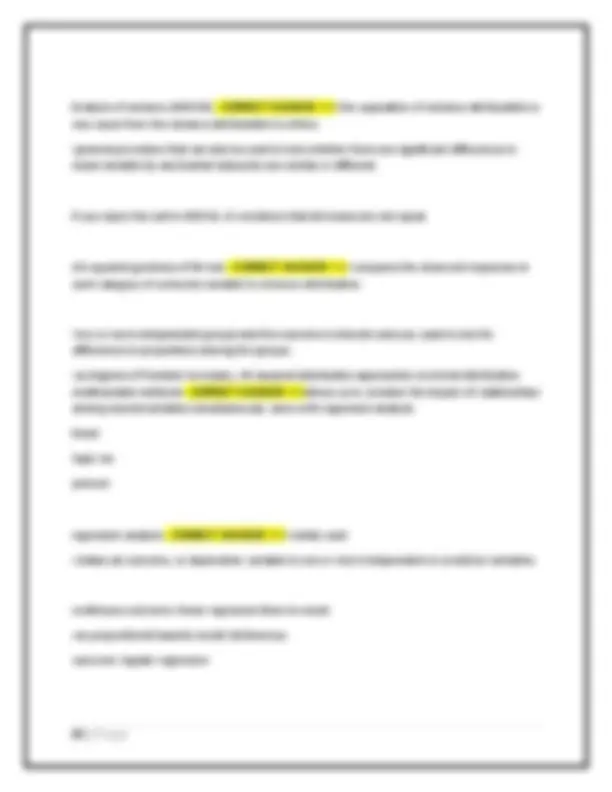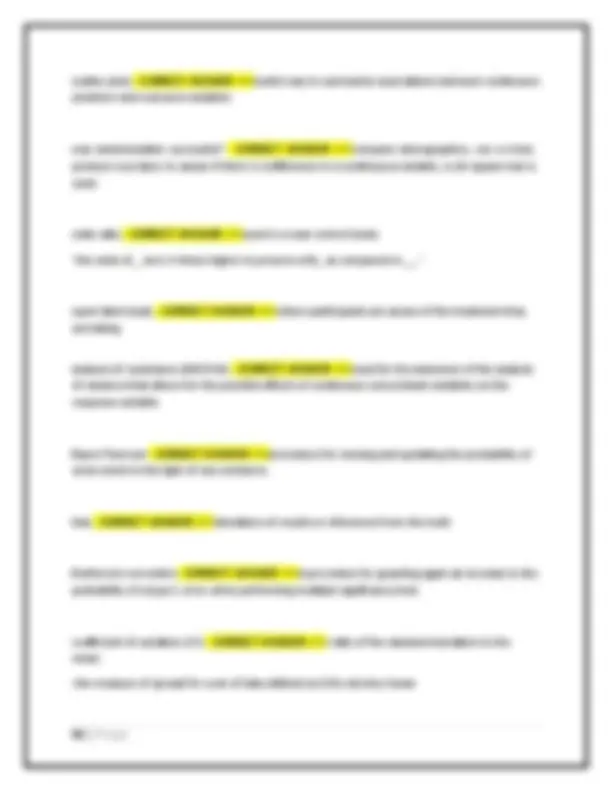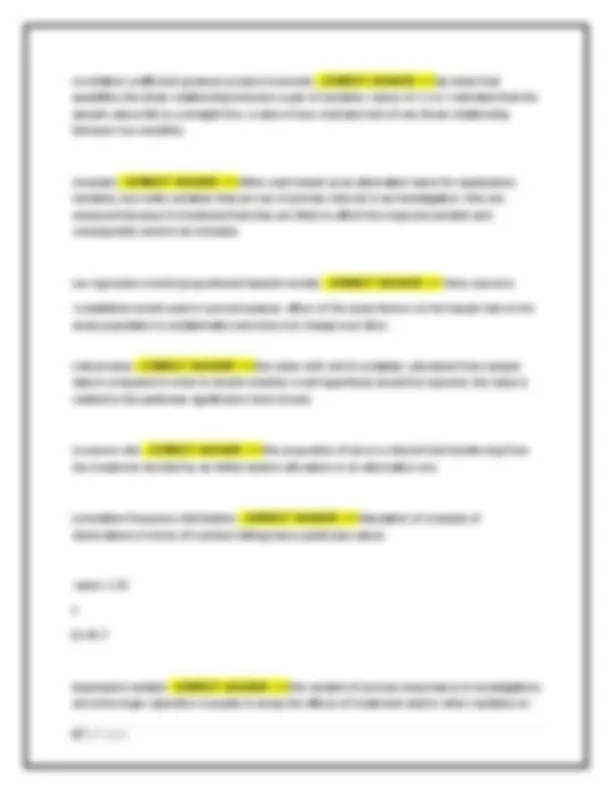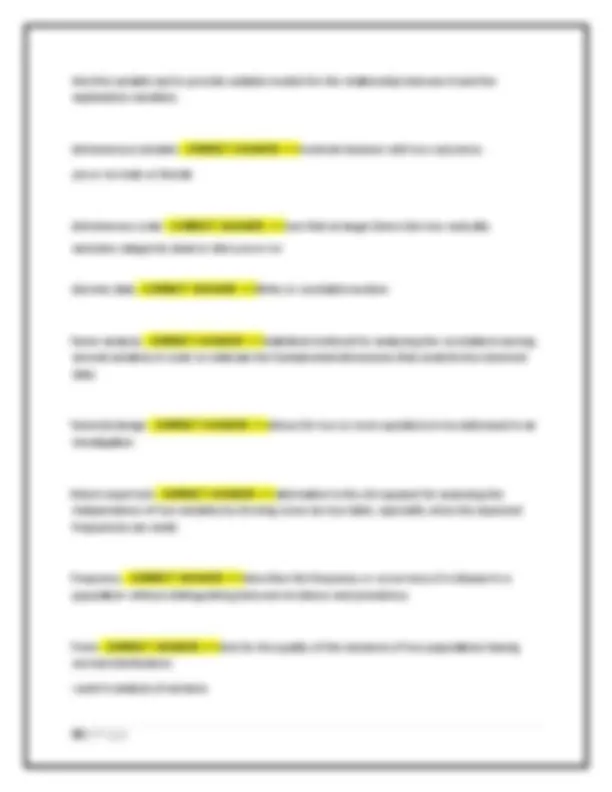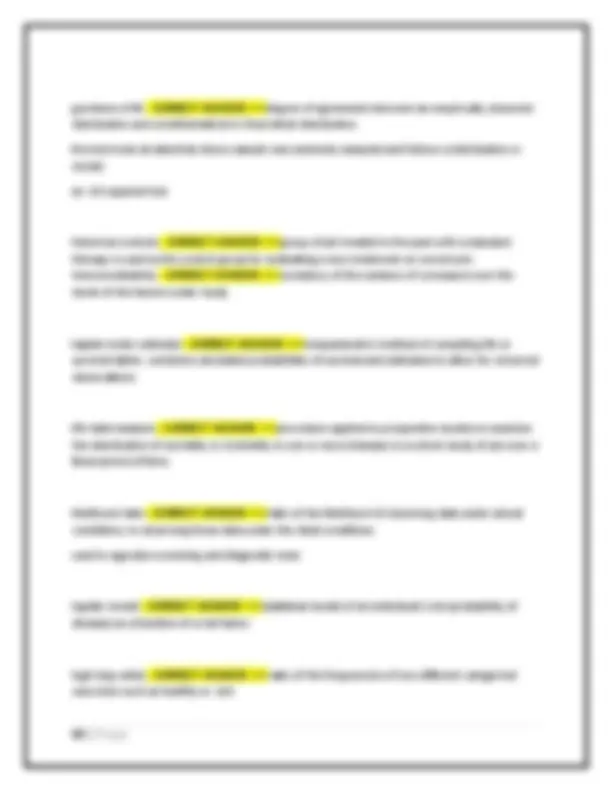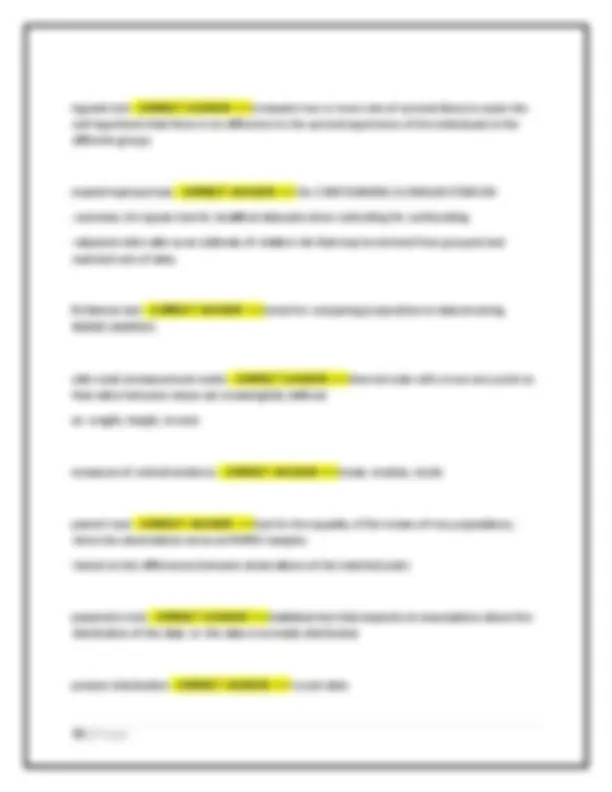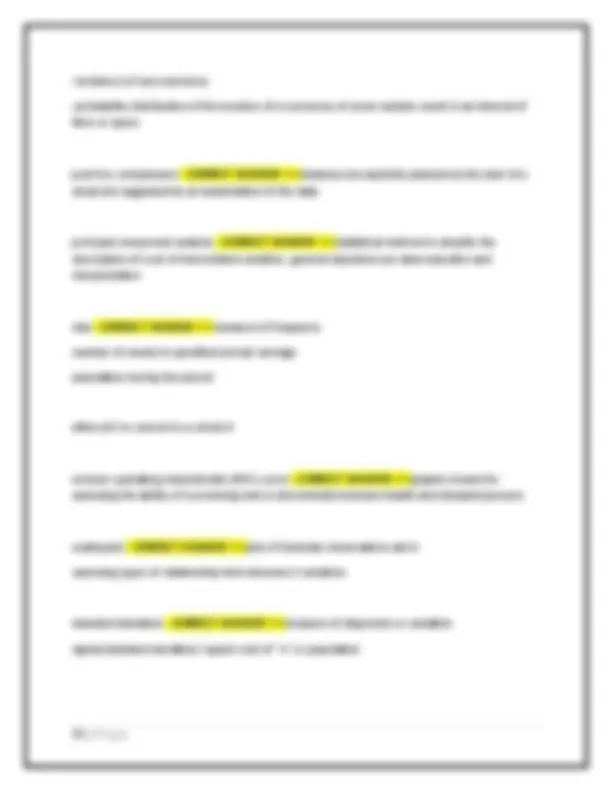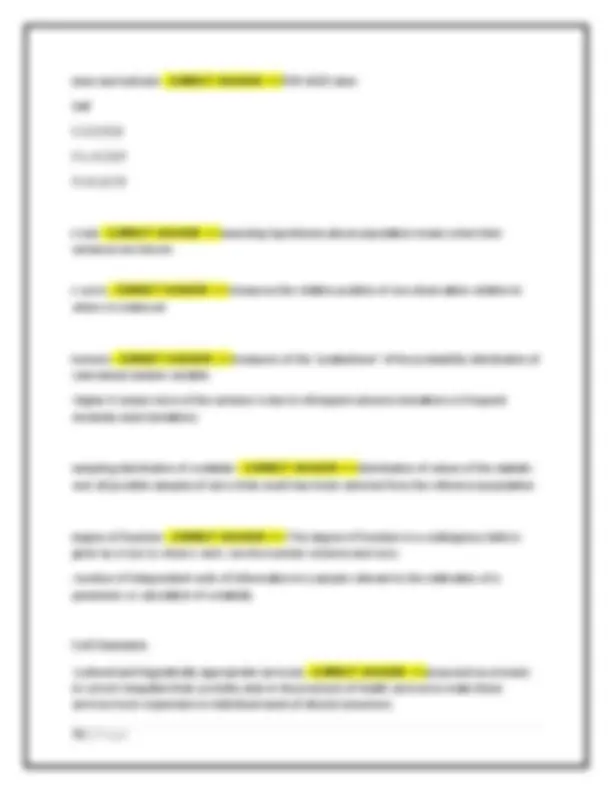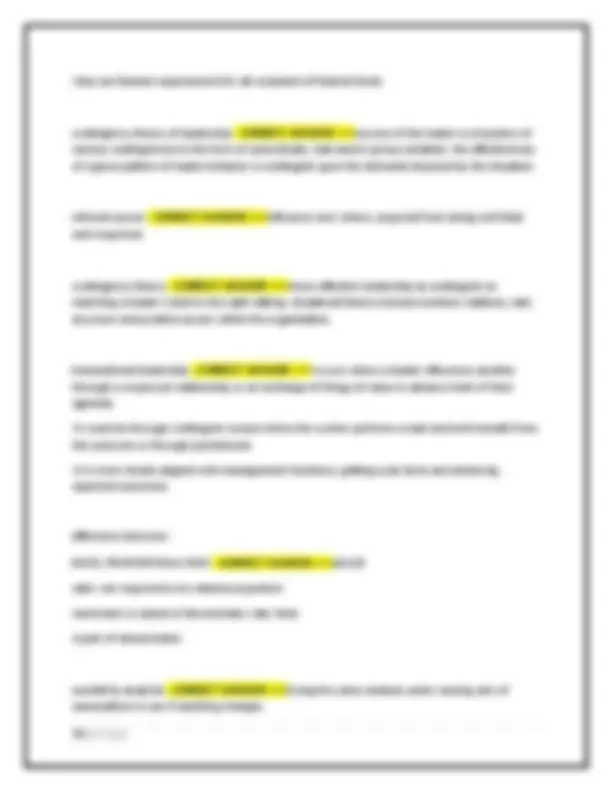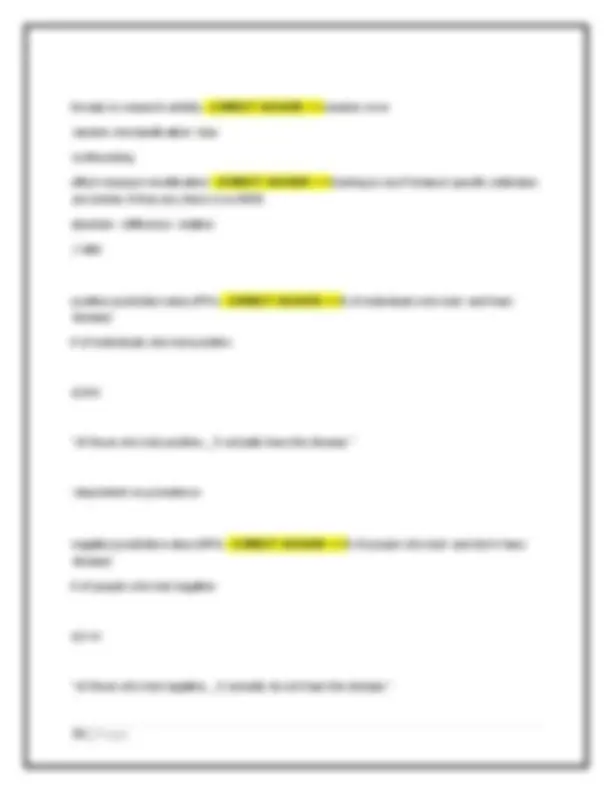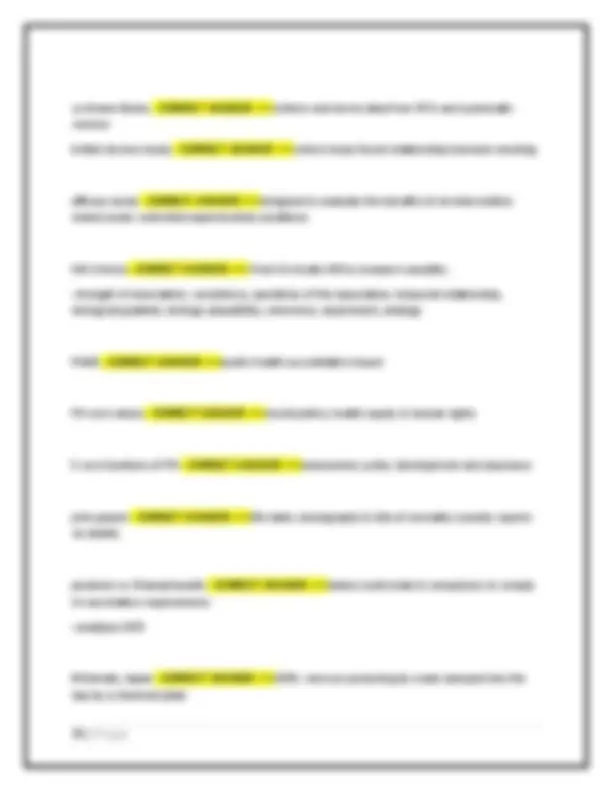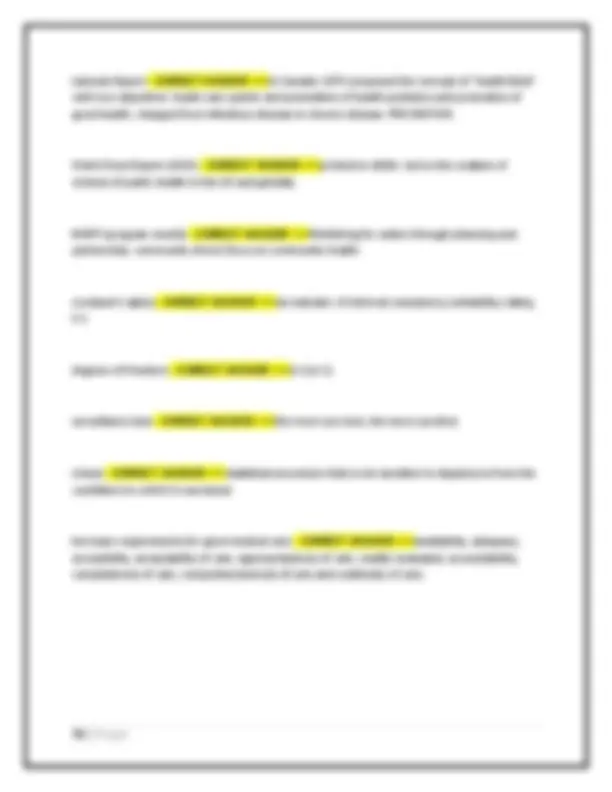Download CPH EXAM FINAL EXAM QUESTIONS & CORRECT ANSWERS (WELL VERIFIED) GRADED A+ and more Exams Nursing in PDF only on Docsity!
CPH EXAM FINAL EXAM QUESTIONS & CORRECT
ANSWERS (WELL VERIFIED) GRADED A+
Attributable risk - CORRECT ANSWER >>> Rate of disease in exposed individuals that can be attributed to the exposure. Or the proportion of all cases that can be attributed to a particular exposure. Adjusted rate - CORRECT ANSWER >>> Effects of differences in composition of pops being compared have been minimized by statistical methods. ex: regression analysis and strandardization
- often used on rates or relative risks Ecological Fallacy - CORRECT ANSWER >>> Bias that may occur because an association observed between variables or an aggregate level does not represent the association that exists at an individual level Confidence Interval - CORRECT ANSWER >>> 95% confident that the true value of a variable is contained within the interval.
- used to account for sampling variability
- it is a point estimate +_ margin of error, where the point estimate is the best estimate of teh unknown parameter and the margin of error is the product of the confidence level and the standard error. if a 95% CI for the differences in mean does not include 0 (the null value) then there is eveidence of a statistically significant difference at sigma=0. Clinical Trial Phases - CORRECT ANSWER >>> 1. Safety and Pharmacologic profiles
- pilot efficacy studies
- extensive clinical trials
- after the FDA approves, look at specific effects to establish incidence of adverse reactions, etc. longterm use effects. interpretation of studies - CORRECT ANSWER >>> temporality: cause precedes effect Specificity: important in assessing the possibility of biases. Consistency: several studies showing similar results. homogeneity statistically. Confounders - CORRECT ANSWER >>> - non-causal association between exposure and outcome as a result of a third variable. - distortion of effect by other factors
- must be related to exposure AND outcome
- not an intermediate variable on causal pathway Controlling for confounders - CORRECT ANSWER >>> before data collection: random collection, individual matching, frequency matching After data collection: direct adjustment, indirect adjustment, mantel-haenszel, regression techniques Quality Assurance vs. Quality Control - CORRECT ANSWER >>> QA: ensure quality before data collection QC: monitor and maintain quality during study reliability vs. validity - CORRECT ANSWER >>> R: precision, reproducibility V: accuracy, absence of bias
frequency matching: a group of controls Minimum Euclidean Distance measure: match to closest person. Cohort Studies - CORRECT ANSWER >>> RISK RATIO, RELATIVE RISK, INCIDENCE RATE, RATE RATIO
- rare exposures
- group of subjects who shared experiences during a particular time. Determines if incidence is related to exposure. Concurrent/longitudinal cohort studies - CORRECT ANSWER >>> starts now (with a baseline exam) and goes into future. expensive and time intensive. non-concurrent/retrospective cohort studies - CORRECT ANSWER >>> assembled in past based on existing records. faster and quicker, but records can be limited or biased. follow up can be hard. Prevalence of disease - CORRECT ANSWER >>> measure of the burden of disease in a community (new and existing cases). the number of events in a given population at a designated time.
- obscures causal relationships point prevalence - CORRECT ANSWER >>> - proportion of pop that is diseased during a single point of time.
- at a specific point in time number of cases at a particular moment/ number in population at that moment period prevalence -
CORRECT ANSWER >>> - proportion of pop that is diseased during a specified duration of time.
- during a specific period of time number of cases during a specified time period/ number in population at midpoint of period incidence of disease - CORRECT ANSWER >>> measure of risk (new cases) the rate at which people without a disease develop the disease during a specific period of time. #of new cases over a period of time/ population @ risk of the disease in that time incidence rate (also incidence density) - CORRECT ANSWER >>> CASES OF DISEASE/PERSONTIME AT RISK TIME is important.
- it shows greater accuracy, but is hard to calculate.
- used for causal research Incidence Proportion - CORRECT ANSWER >>> CASES OF DISEASE/PERSONS AT RISK cumulative risk/average risk the proportion of a group of people who experience the onset of a health-related event during a specified time interval. Incidence Odds - CORRECT ANSWER >>> CASES OF DISEASE/SURVIVORS
Selection Bias - CORRECT ANSWER >>> When sample/participants aren't representative. how to avoid: control confounders and choose good comparison group. power - CORRECT ANSWER >>> - the ability to reject the null hypothesis when the null is in fact false.
- probability of detecting a difference if one truly exists. 1-beta= probability of declaring a difference not statistically significant when a difference truly exists. Type 1 Error - CORRECT ANSWER >>> reject the null hypothesis when it is true alpha or Type 11 Error - CORRECT ANSWER >>> fail to reject the null hypothesis when it is false beta aggregate data - CORRECT ANSWER >>> vital stats, data from govt databases, summaries from reporting systems, production and sales data, group-level. COMBINED individual level data - CORRECT ANSWER >>> questionnaires, medical records, national surveys, biological specimens Stages of disease prevention - CORRECT ANSWER >>> Primary, secondary, tertiary Primary Disease Prevention - CORRECT ANSWER >>> Prevent it from occurring (vaccines) Secondary Disease Prevention - CORRECT ANSWER >>> Modify severity (better access to ER) Tertiary Disease Prevention - CORRECT ANSWER >>> Rehabilitation. measures to prevent reoccurrence of disease
Rate of Disease - CORRECT ANSWER >>> how fast is the disease occurring in the population Proportion of Disease - CORRECT ANSWER >>> What fraction of the population is affected? Case Fatality (CF) or Fatality Rate - CORRECT ANSWER >>> Measures of the severity of disease. 9 deaths per 10,000/1 year Within a given year, out of 10,000 people diagnosed with a disease, 9 died. Secondary Attack Rate (person-to-person spread) - CORRECT ANSWER >>> # of persons sick by the primary case/# exposed to primary case Attack Rate - CORRECT ANSWER >>> # of people at risk who develop disease /# of people at risk Outbreak investigation steps - CORRECT ANSWER >>> 1. define epidemic
- look for the time-place interaction of cases
- look for combination of variables
- Develop hypothesis
- Recommend control measures Common Source Outbreaks - CORRECT ANSWER >>> groups of persons exposed to common agent Propagated Outbreaks - CORRECT ANSWER >>> spreads gradually from person to person Mixed epidemic Outbreaks - CORRECT ANSWER >>> both common source and person to person exposure
metabolites - CORRECT ANSWER >>> substance produced by biological processes metabolomics - CORRECT ANSWER >>> use of genomic information to facilitate studies of metabolic processes. Latency - CORRECT ANSWER >>> time from 1st exposure until the appearence of a toxic effect. IRIS (integrated risk information system) - CORRECT ANSWER >>> descriptive, quantitative regulatory information on chemicals. health professionals not experts. Incidence - CORRECT ANSWER >>> # of new cases in a defined population over a specific time period. hydrophilic - CORRECT ANSWER >>> strong affinity for water hydrophobic - CORRECT ANSWER >>> strong aversion for water helminths - CORRECT ANSWER >>> group of parasites that infect humans (Schistosoma haematobium) cestodes: beef and pork tapeworms HACCP (hazard analysis and critical control points) - CORRECT ANSWER >>> production control system for the food industry. identifies potential contamination and then strictly manages and monitors points. designed to prevent rather than catch. gray (Gy) - CORRECT ANSWER >>> international system unit of absorbed dose
exposure-dose reconstruction - CORRECT ANSWER >>> method of estimating the amount of past exposures to hazardous substances. computers and approximation methods can be used when info is missing or limited. EPCRA (emergency planning and community right-to-know act) **- CORRECT ANSWER
** requirements for federal, stat and local govts regarding emergency planning and CRTK reporting on hazardous and toxic chemicals.
- triggered by Bhopal, India 2,000 people died by release of methyl isocyanate. ED50 - CORRECT ANSWER >>> dose of drug that is pharmacologically effective for 50% of the population. disease vector - CORRECT ANSWER >>> intermediate host for parasites. required for development. delivers parasite to subsequent hosts. ex: schistosoma Curie - CORRECT ANSWER >>> basic unit to describe the intensity of radioactivity in a sample of material. cryptosporidium - CORRECT ANSWER >>> microbe that is transmitted through water and person-to-person contact. causes acute diarrhea, stomach pain, vomiting, fever.
- milwaukee episode, largest waterborne disease outbreak. Criteria Pollutants - CORRECT ANSWER >>> 1970 ammendment to Clean Air Act. required EPA to set standards for 6 pollutants. ozone, carbon monoxide, total suspended particles, sulfurdioxide, lead, nitrogenoxide.
Epidemiology's basic ethical principles - CORRECT ANSWER >>> 1. respect for people
- Beneficence (do not harm)
- Justice Applications of Epidemiology's basic ethical principles - CORRECT ANSWER >>> 1. informed consent
- assessment of risk and benefit
- selection of subjects Tuskegee Syphilis Experiment - CORRECT ANSWER >>> A clinical study conducted between 1932 and 1972 in Tuskegee, Alabama by The U.S. Public Health Service. 399 impoverished African American sharecroppers with syphilis were recruited for research related to the natural progression of the untreated disease. After penicillin was discovered as a cure, researchers continued to deny such treatments to medical participants for another 25 years. Many patients were lied to and given placebo treatments so researchers could observe the progression of the fatal disease. This study led to the 1979 Belmont Report and establishment of the Office for Human Research Protection (OHRP). In 1974, Congress passed the National Research Act and created a commission to study and write regulations governing studies involving human participants. Accuracy - CORRECT ANSWER >>> The degree to which a measurement or an estimate based on measurements represents the true value of the attribute that is being measured. Acute Disease - CORRECT ANSWER >>> a health effect with sudden onset, often brief. sometimes used to mean severe. adjusted rate - CORRECT ANSWER >>> a rate in which the effects of differences in composition of the populations being compared have been minimized by statistical measures.
Association - CORRECT ANSWER >>> statistical dependence between two or more events, characteristics or other variables. attack rate - CORRECT ANSWER >>> the cumulative incidence of infection in a group observed over a period during an epidemic. Crude rate - CORRECT ANSWER >>> a summary rate based on the actual number of events in a population over a given time period. death rate - CORRECT ANSWER >>> an estimate of the portion of a population that dies during a specific period. #of people dying /population Ecologic study - CORRECT ANSWER >>> a study in which the units of analysis are populations or groups of people rather than individuals. etiology - CORRECT ANSWER >>> the science of causes, causality. Hawthorne Effect - CORRECT ANSWER >>> The effect of knowing that you're being studied influences behavior. healthy worker effect - CORRECT ANSWER >>> workers usually exhibit lower overall death rates than the general population because chronically ill are bared from employment. index case - CORRECT ANSWER >>> the first case in a family or other defined group to come to the attention of the investigator
proportional mortality ratio - CORRECT ANSWER >>> the proportion of observed deaths from a specified condition in a defined population, divided by the proportion of deaths expected from the condition in a standard population. expressed on an age-specific basis or after age adjustment. p-value - CORRECT ANSWER >>> the probability that a test statistic would be as extreme as or more extreme than observed if the null hypothesis were true. small p-value <.05 leads to rejection of the null hypothesis. the result is statistically significant. large p-value >.05 leads to fail to reject the null hypothesis. there was no effect. quasi-experimental study - CORRECT ANSWER >>> investigator lacks full control over allocation or timing, but conducts the study as if it were an experiment. relative risk - CORRECT ANSWER >>> - measure of the association between exposure to a particular factor and risk of a cetain outcome.
- doesn't measure probability that someone with the factor will develop the disease incidence rate among exposed/ incidence rate among nonexposed sensitivity - CORRECT ANSWER >>> the proportion of truly diseased persons in the screened population who are identified as diseased by the screening test. "of those who have the disease, __% will test positive"
disease not diseased total positive a b a+b negative c d c+d total a+c b+d a+b+c+d a= true positives b= false positives c=false negatives d=true negatives sensitivity = a/(a+c) specificity= d/(b+d) predictive value (positive test result) a/(a+b) predictive value (negative test result) d/(c+d) standardized mortality ratio - CORRECT ANSWER >>> the ratio of the number of deaths observed in the study group or population to the number that would be expected if the study population had the same specific rates as the standard population x100. usually a percentage. temporality - CORRECT ANSWER >>> the timing of information about cause and effect. Validity - CORRECT ANSWER >>> measurement: does it measure what it says it does? study: the degree to which the inferences drawn from the study are warranted. vital statistics - CORRECT ANSWER >>> systematically tabulated information on deaths, births, marriages, etc.
bench-scale tests - CORRECT ANSWER >>> lab testing of potential clean up technologies Basal Metabolic Rate - CORRECT ANSWER >>> the rate at which heat is given off by an organism at complete rest background level - CORRECT ANSWER >>> 1. the concentration of a substance in the environment that occurs naturally or is not the result of humans.
- the concentration in a defined area during the fixed time before data was gathered. ALARA - CORRECT ANSWER >>> AS LOW AS IS REASONABLY ACHIEVEABLE best interest vs. economics of improvements and utilization of nuclear energy Apoptosis - CORRECT ANSWER >>> programmed cell death. the body's normal method of disposing of damaged or unwanted cells. Antagonism/Antagonistic Effect - CORRECT ANSWER >>> combined effect of 2+ factors is smaller than the solitary effect of any single factor analyte - CORRECT ANSWER >>> a substance that is undergoing analysis or being measured Additive effect - CORRECT ANSWER >>> biologic response to exposure to multiple substances that equals the sum of responses to all the individual substances added together. Acute exposure - CORRECT ANSWER >>> a single exposure to a toxic substance which may result in severe harm or death. no longer than one day. Environmental Justice & Executive Order 12989 - CORRECT ANSWER >>> - Bill Clinton
- fair treatment and meaningful involvement of ALL people in development and enforcement of environmental laws, regulations, and policies.
- US EPA, ATSDR and NIEHS?NIH to address the disproportionately high impact on health for minority and low-income communities. Health Impact assessments - CORRECT ANSWER >>> - Used to guide land use decisions and community design with a PH lens.
- screen for usefulness
- scoping to identify health effects of concern
- assessing risks and benefits for target pop
- make recommendations
- report findings
- evaluate how HA affected final decision The 4 components of risk assessments - CORRECT ANSWER >>> Hazard identification, doseresponse evaluation, exposure assessment, risk characterization RA: Hazard identification - CORRECT ANSWER >>> identify contaminants that may cause hazards and identify contaminants of concern to be further evaluated. RA: dose-response evaluation - CORRECT ANSWER >>> quantitatively determine the relationship between exposure to toxicant and disease. relies on mathimatical models. RA: exposure assessment - CORRECT ANSWER >>> development of quantitative estimate of magnitude, duration, frequency and timing of an exposure to toxicant RA: risk characterization - CORRECT ANSWER >>> integrates all other steps to estimate risk.

